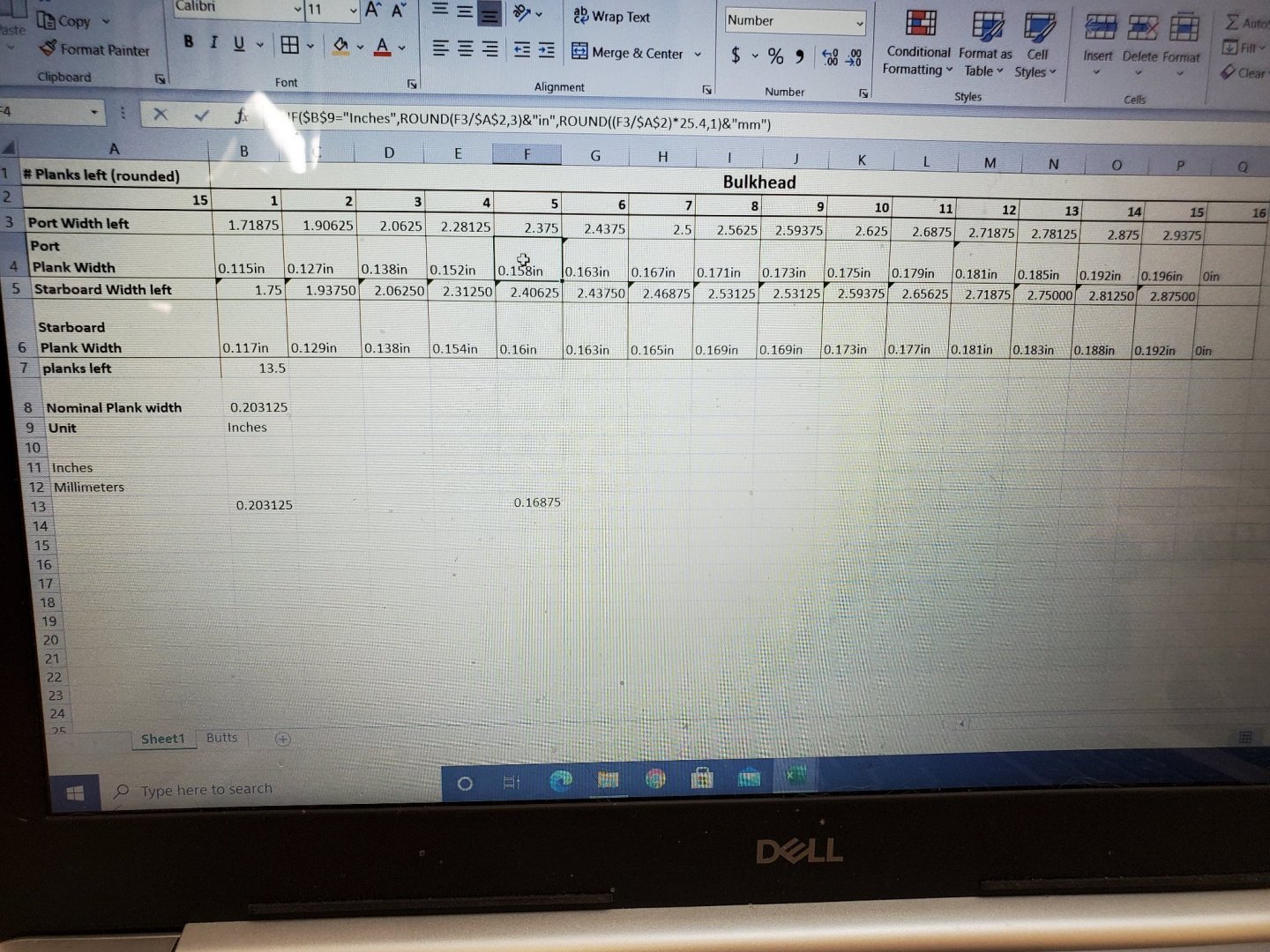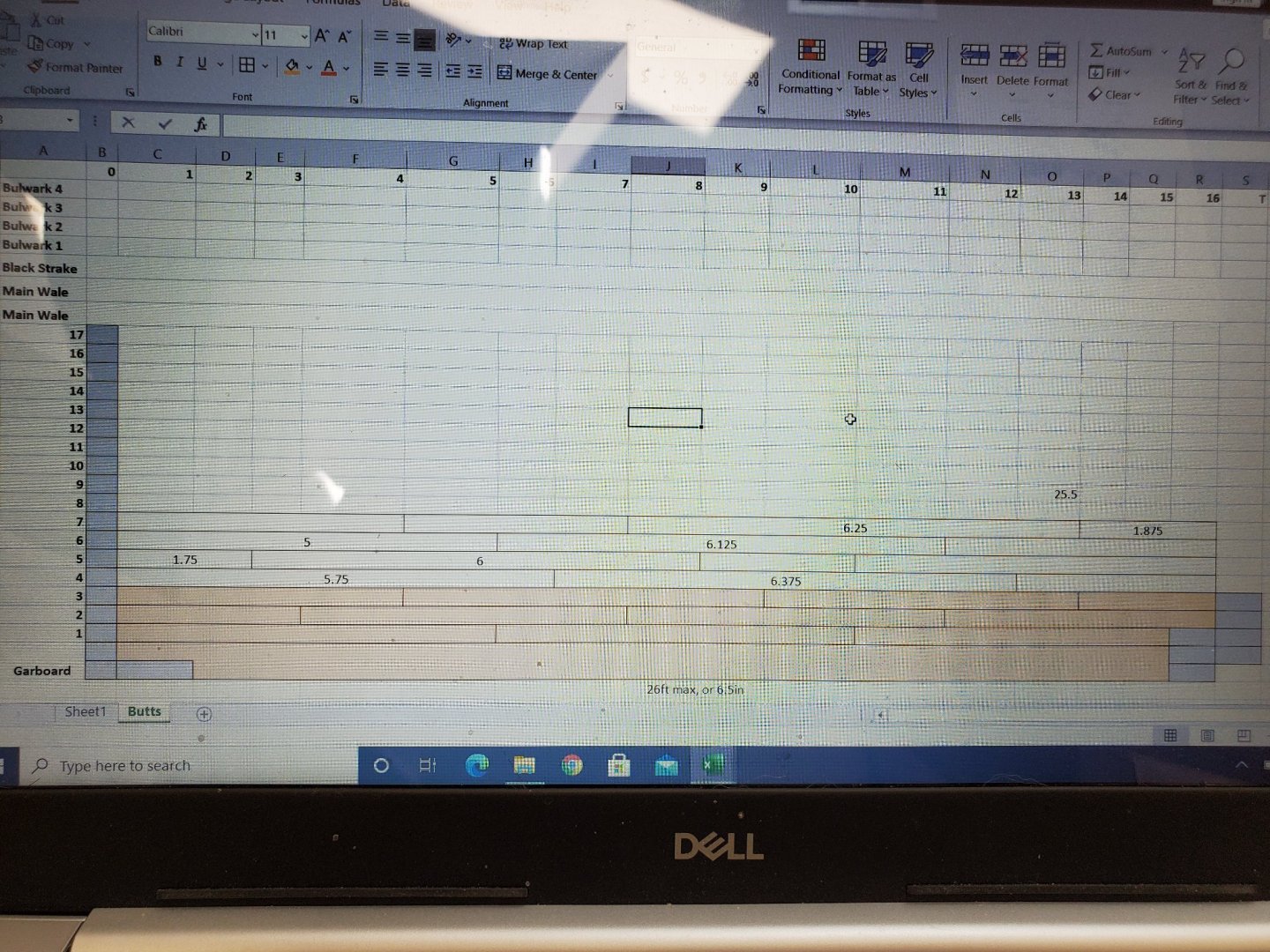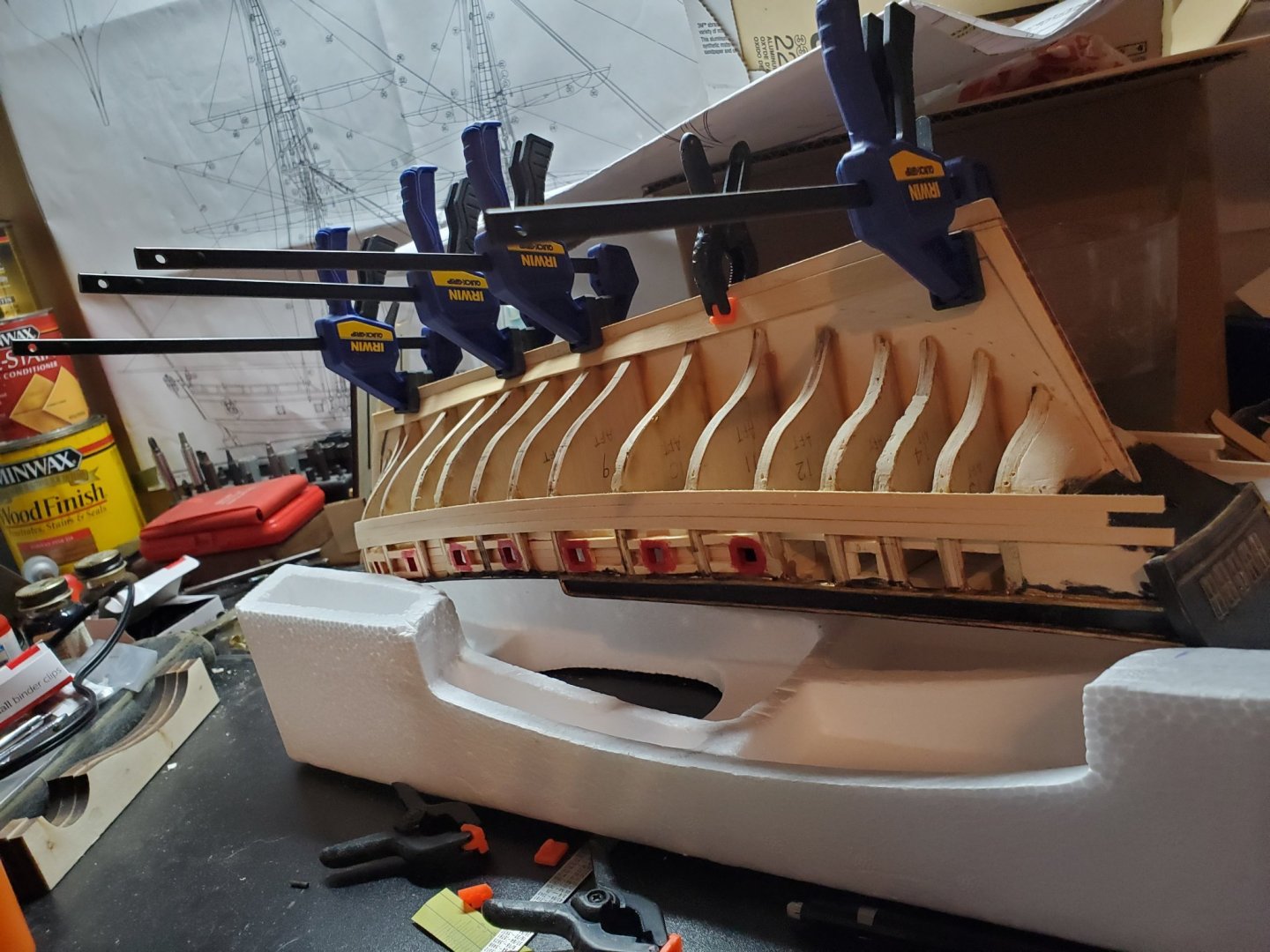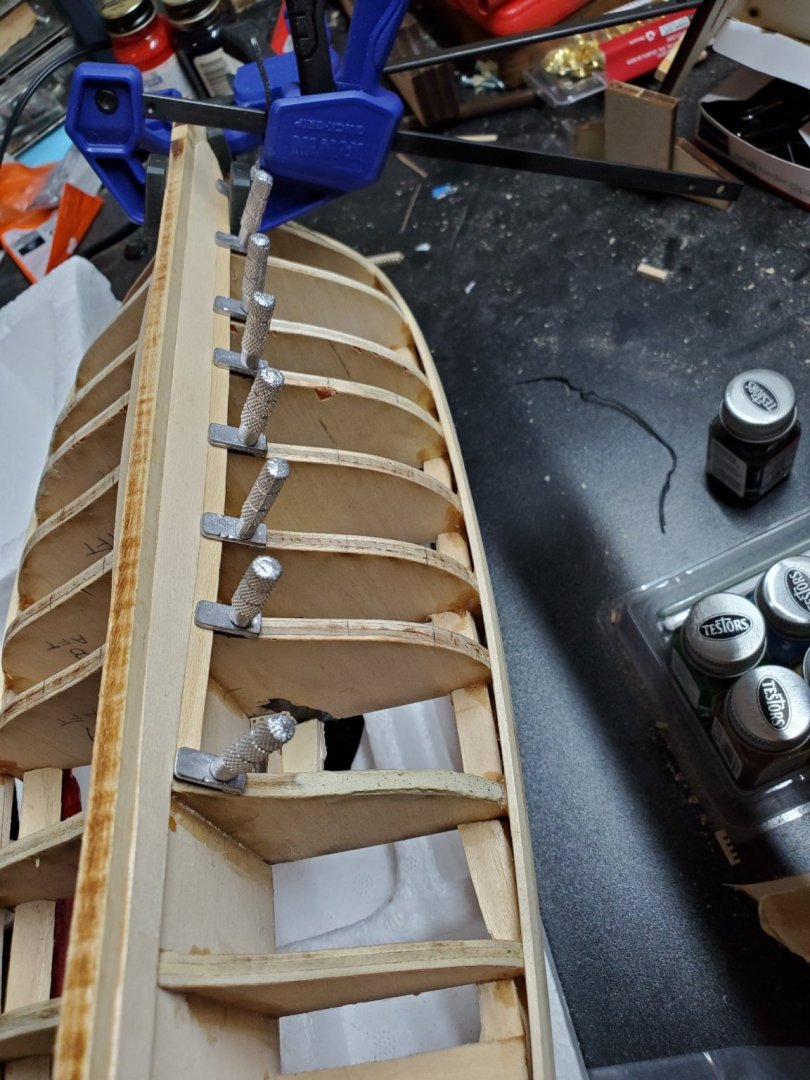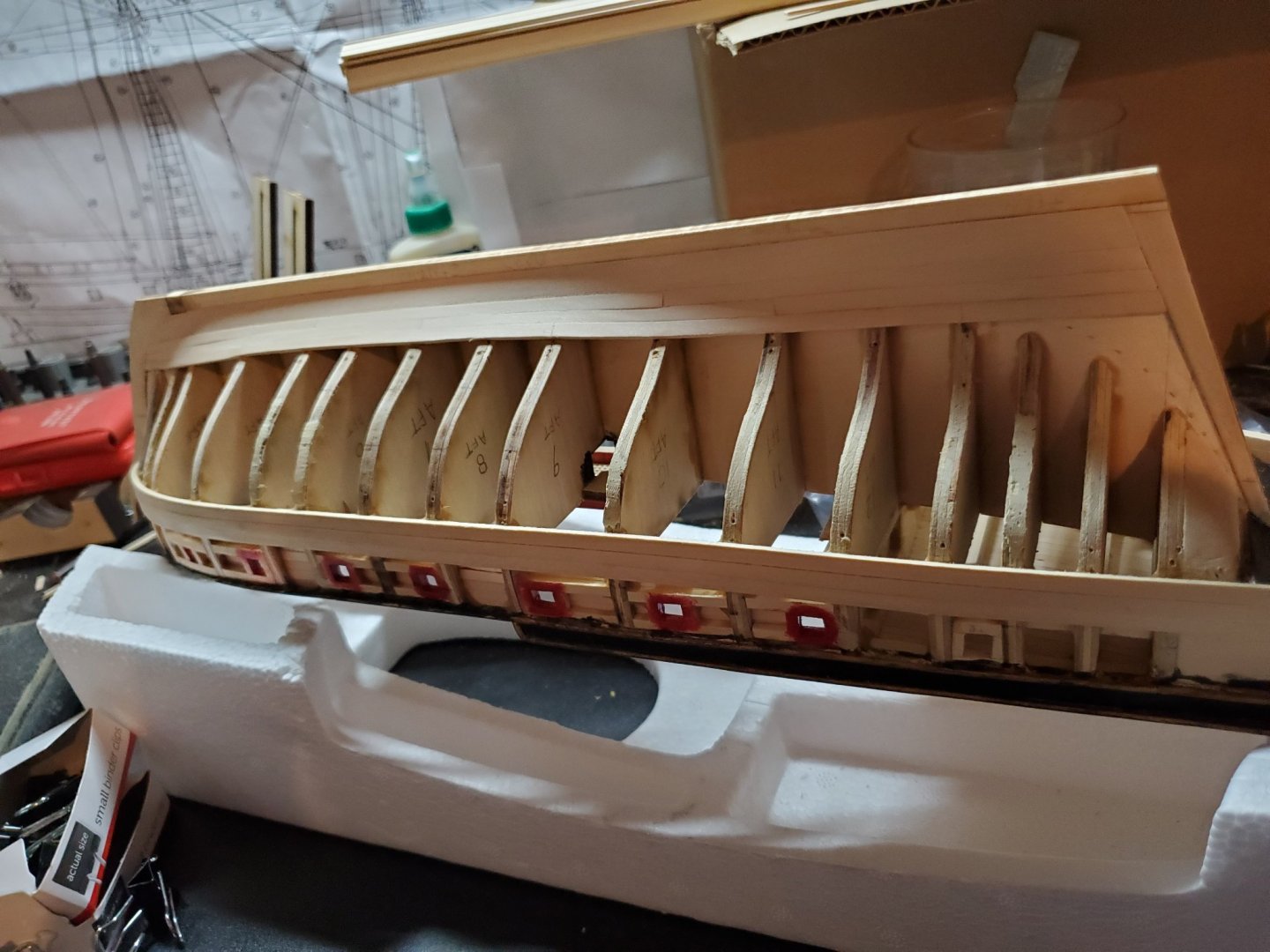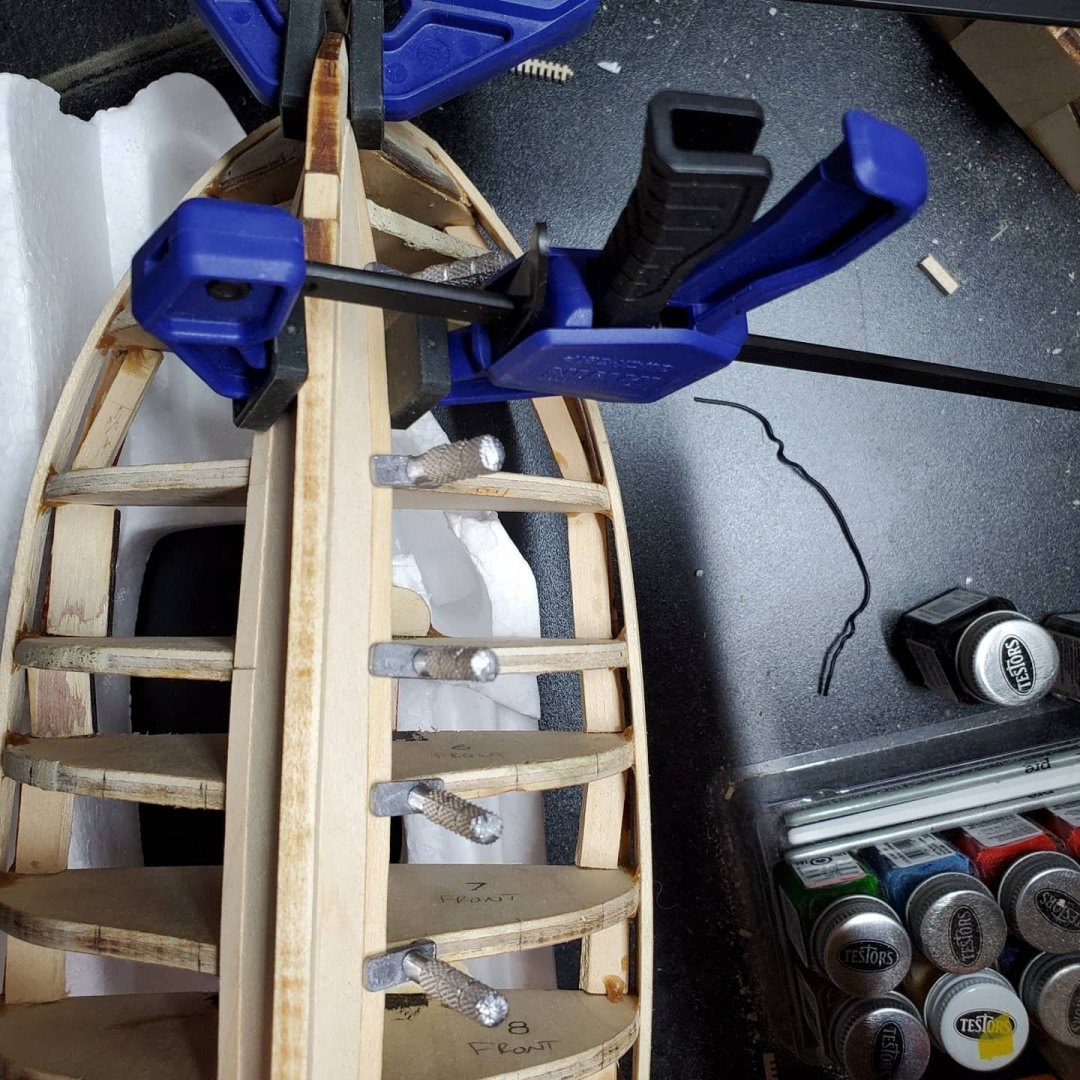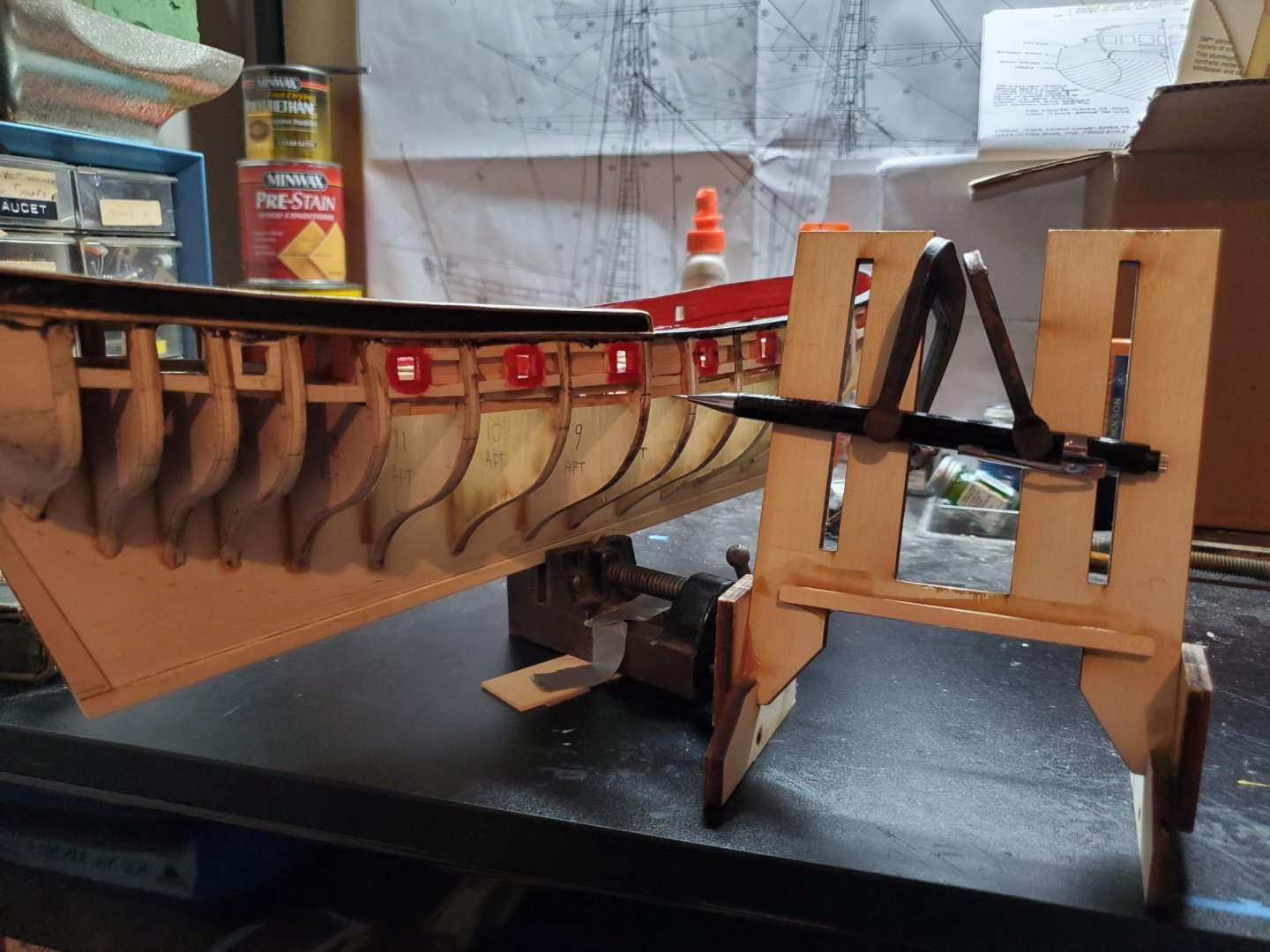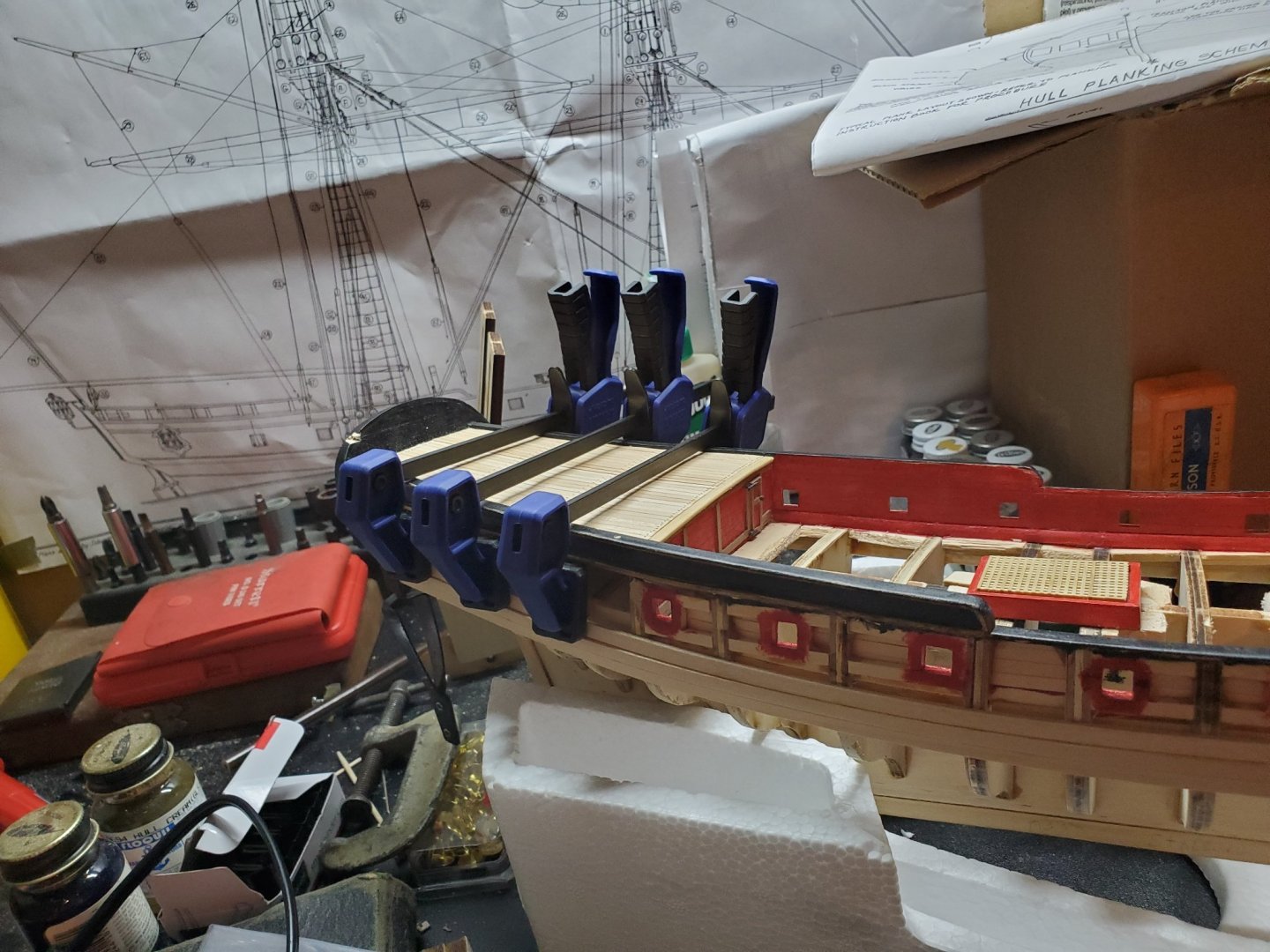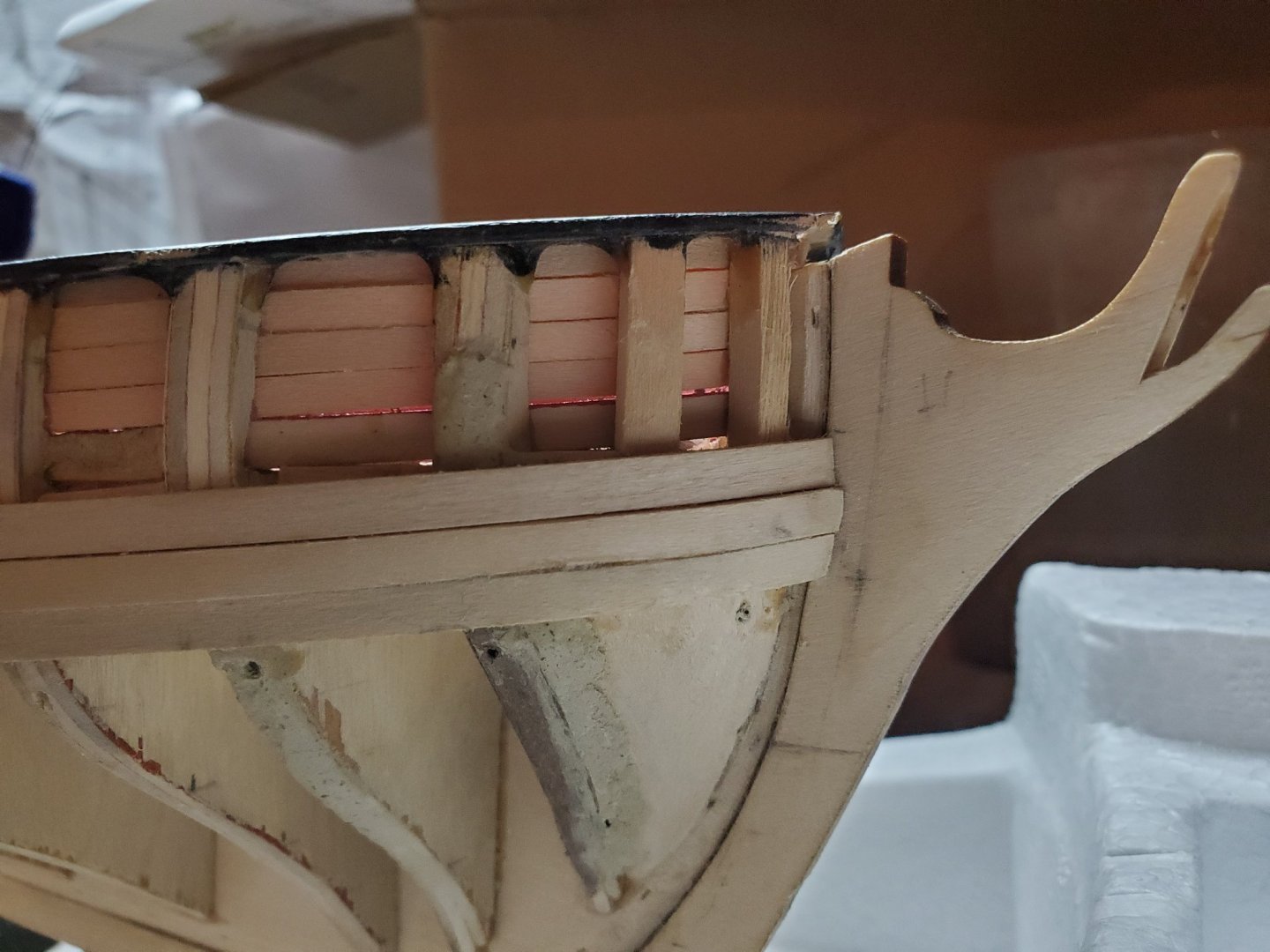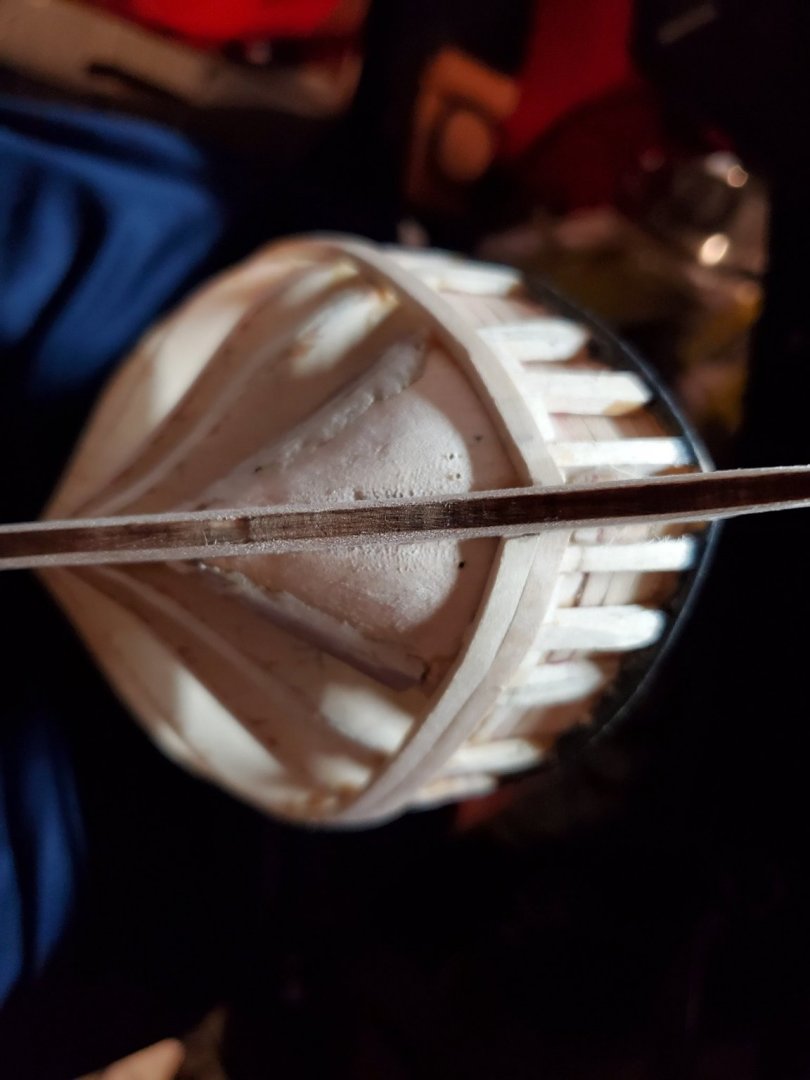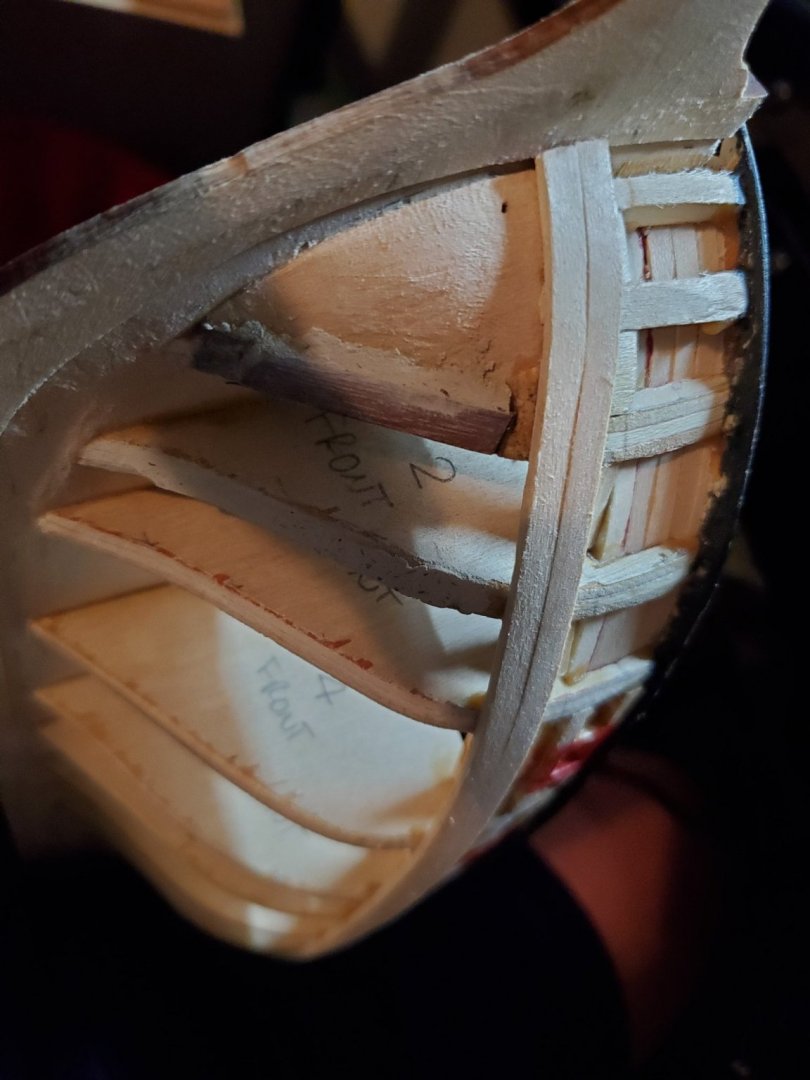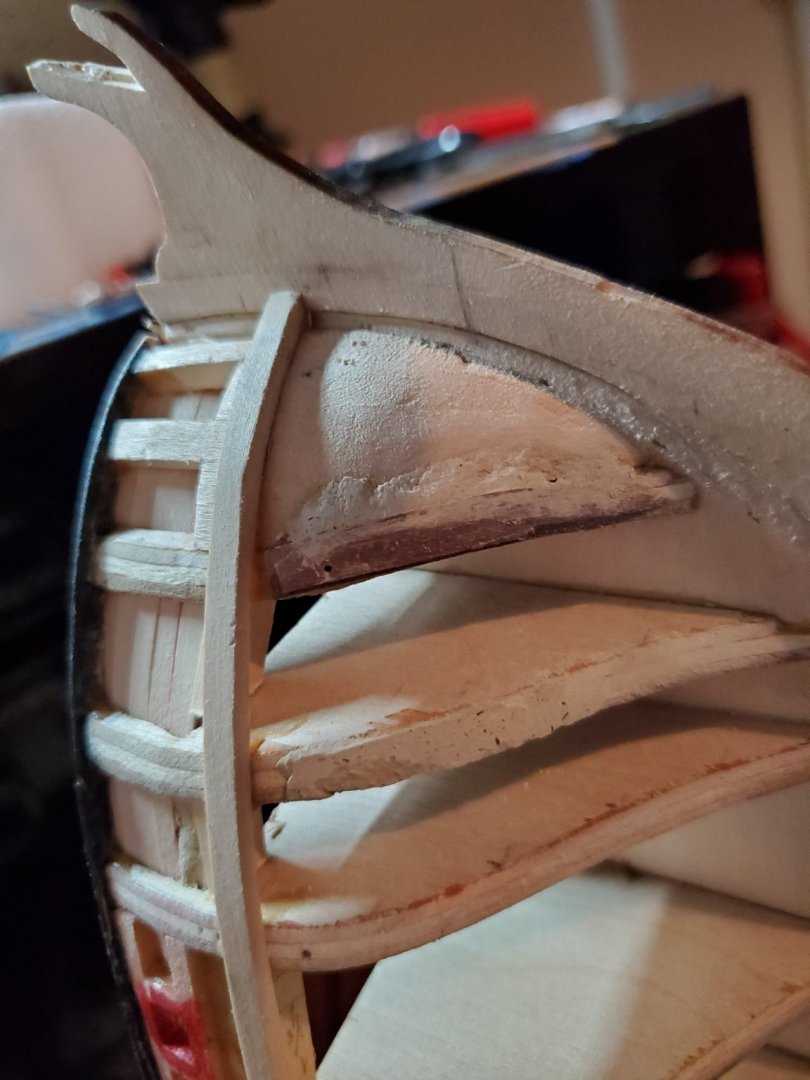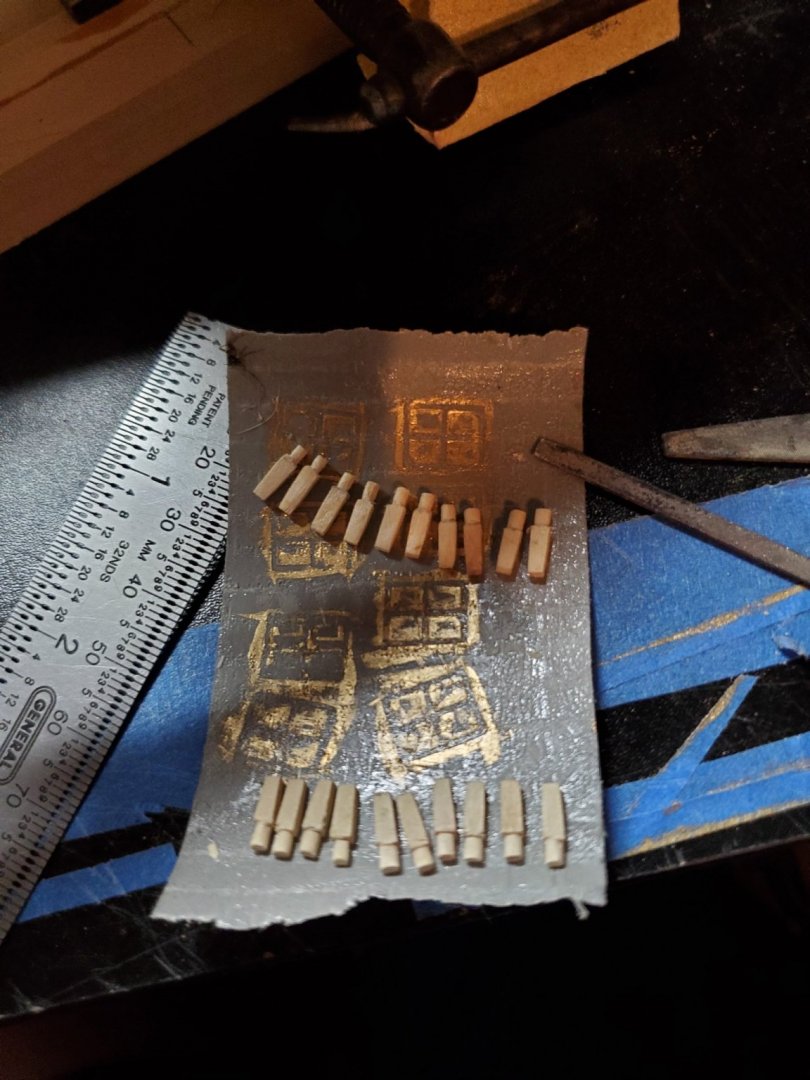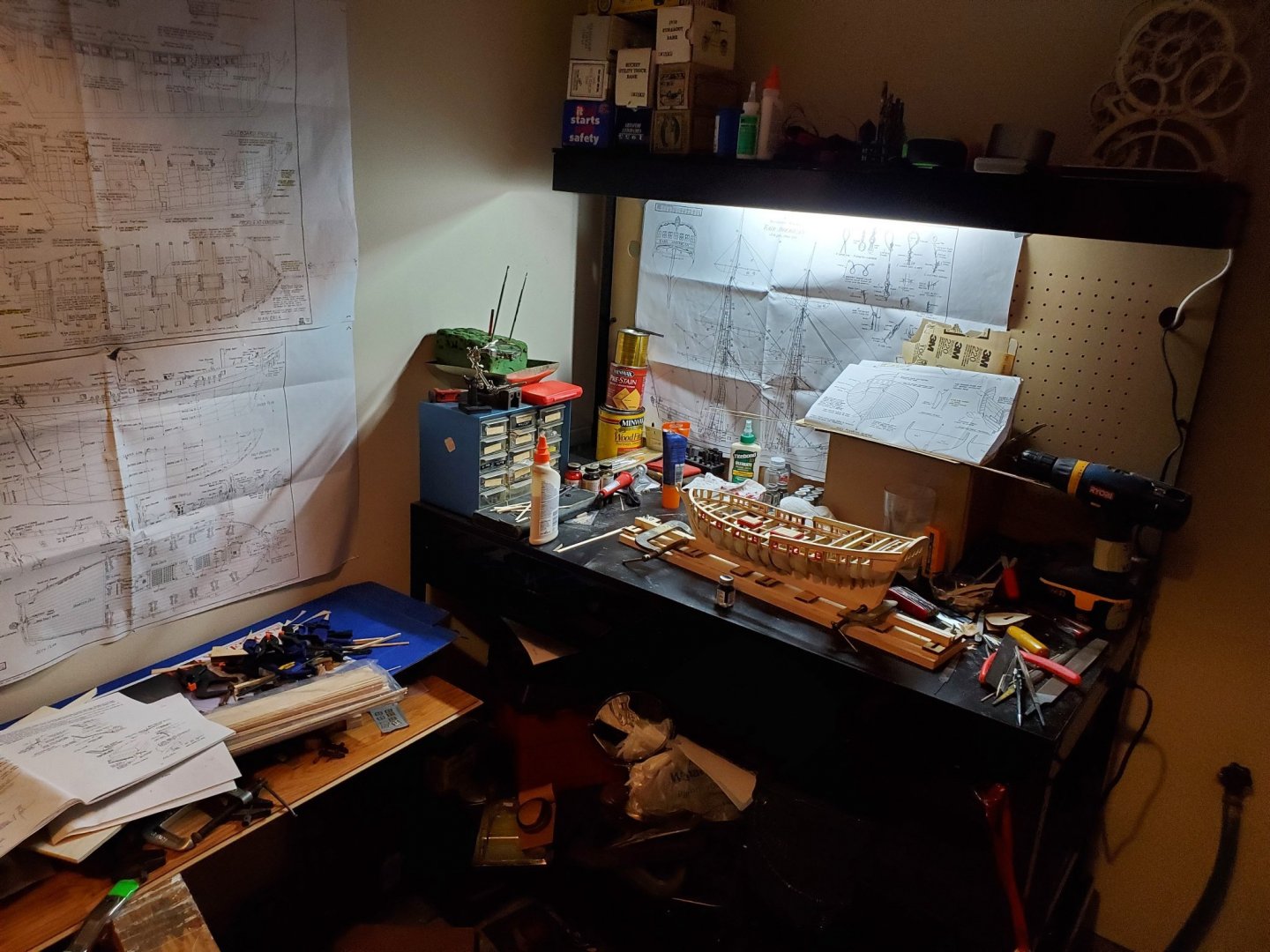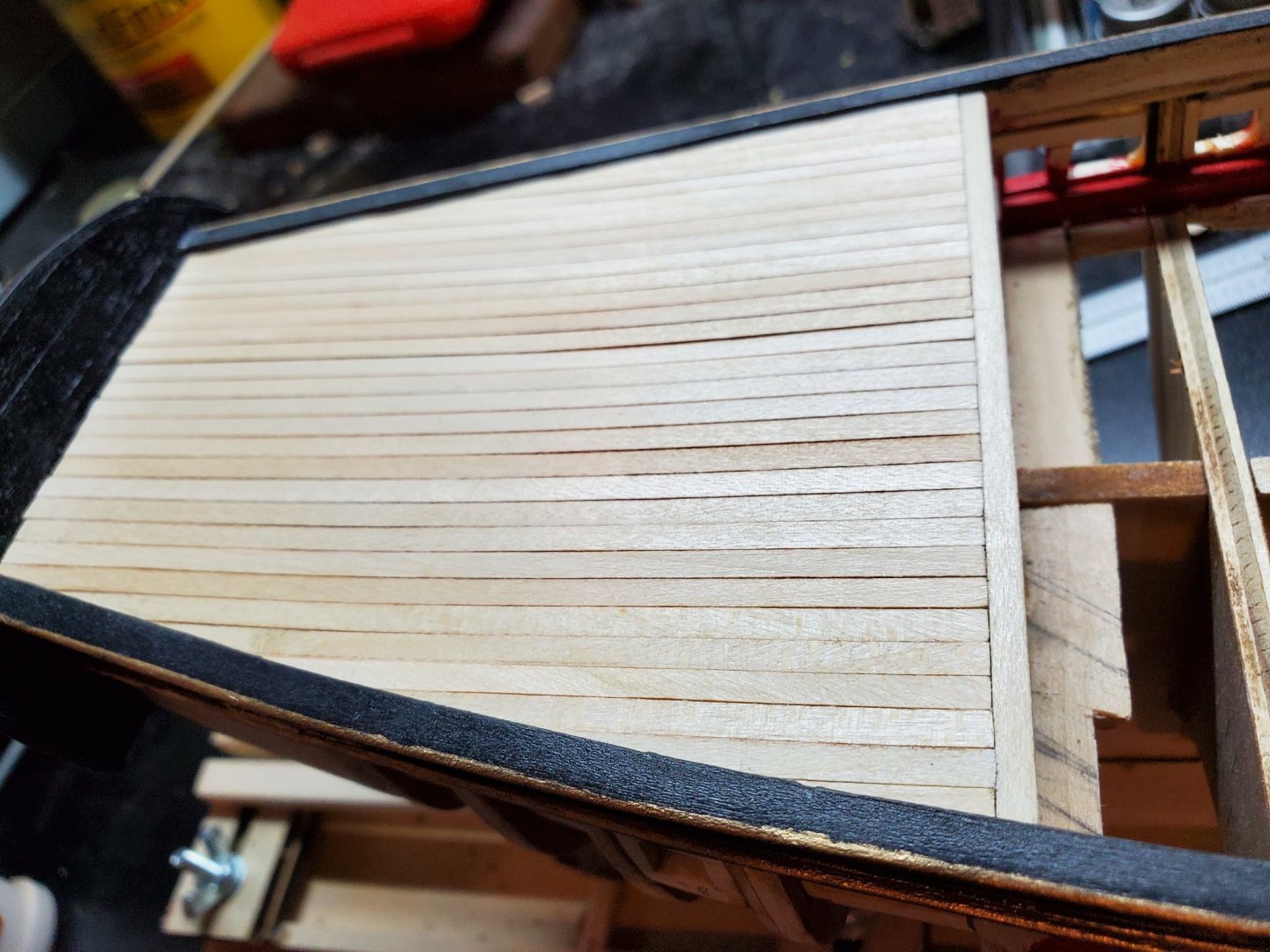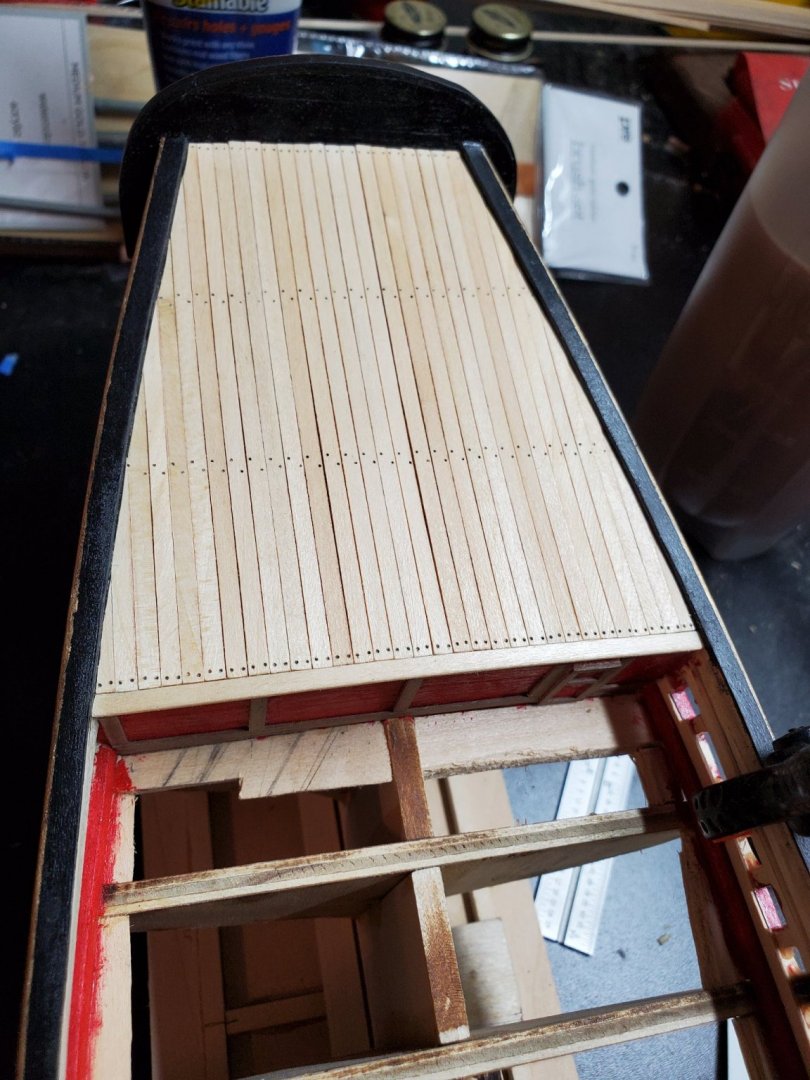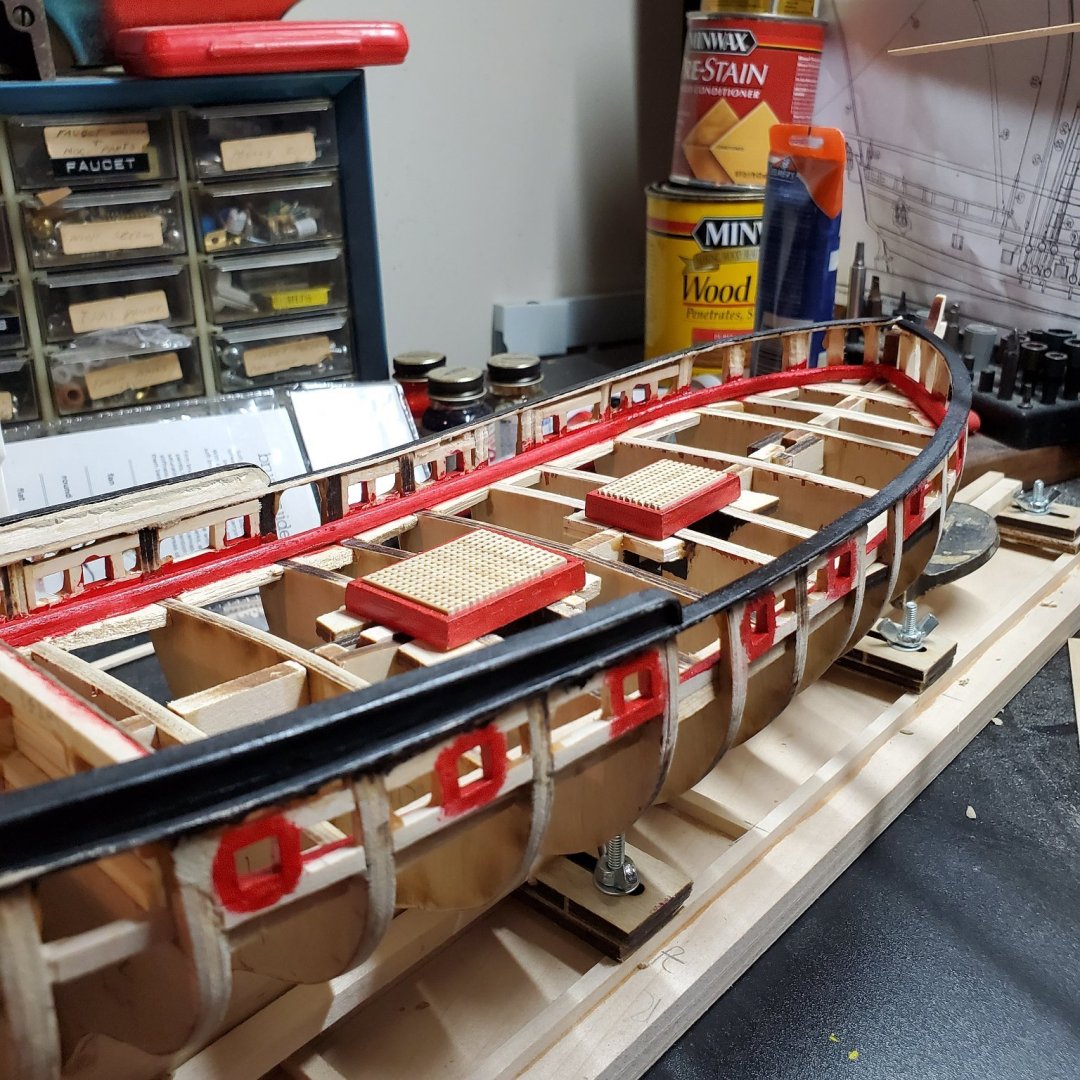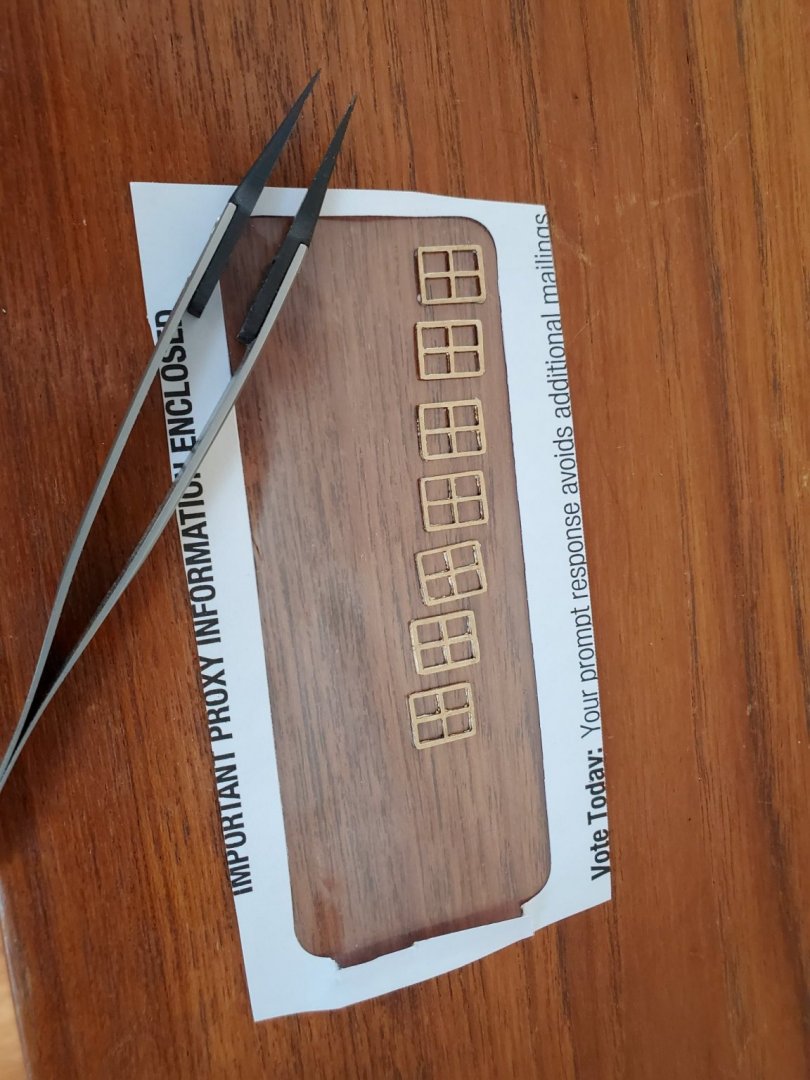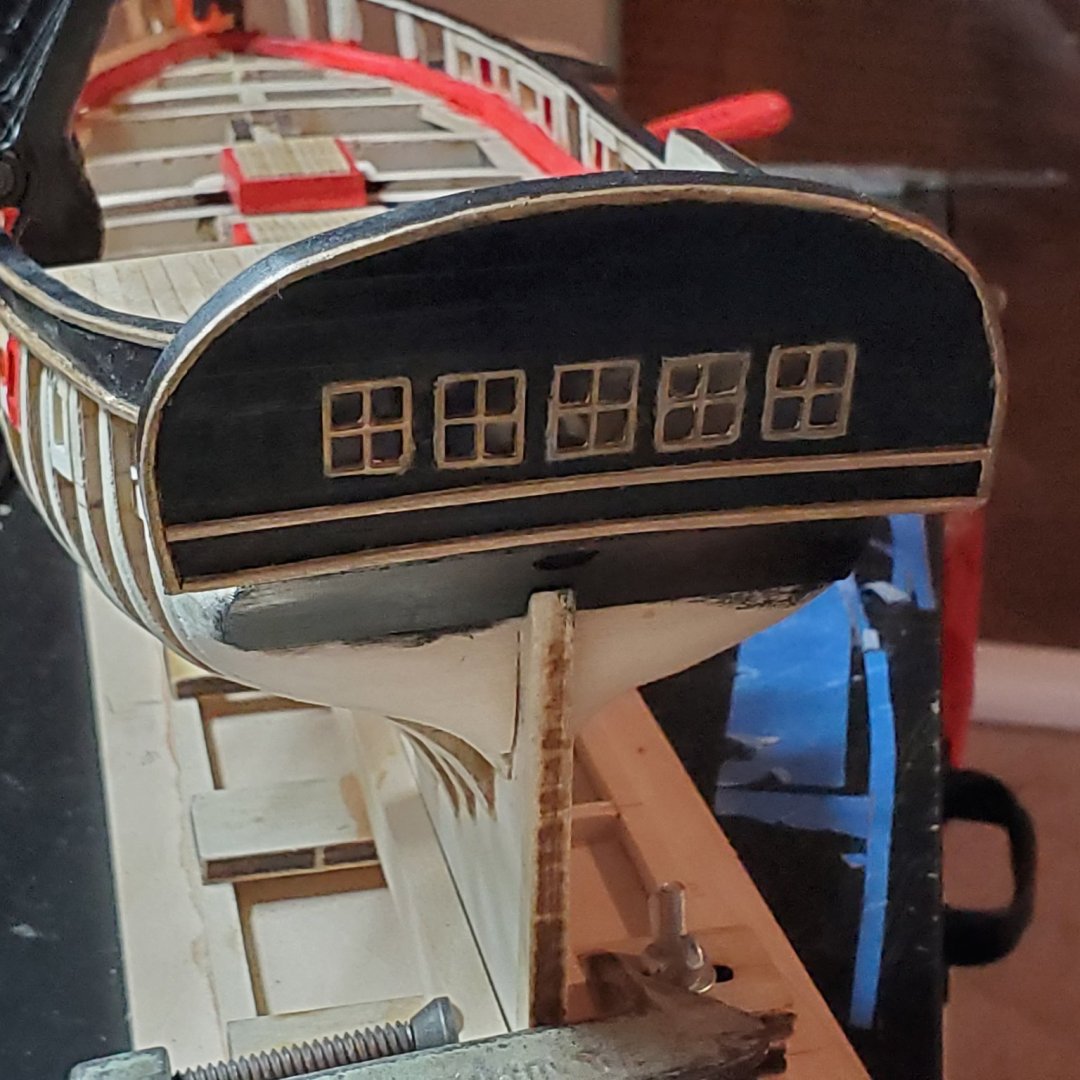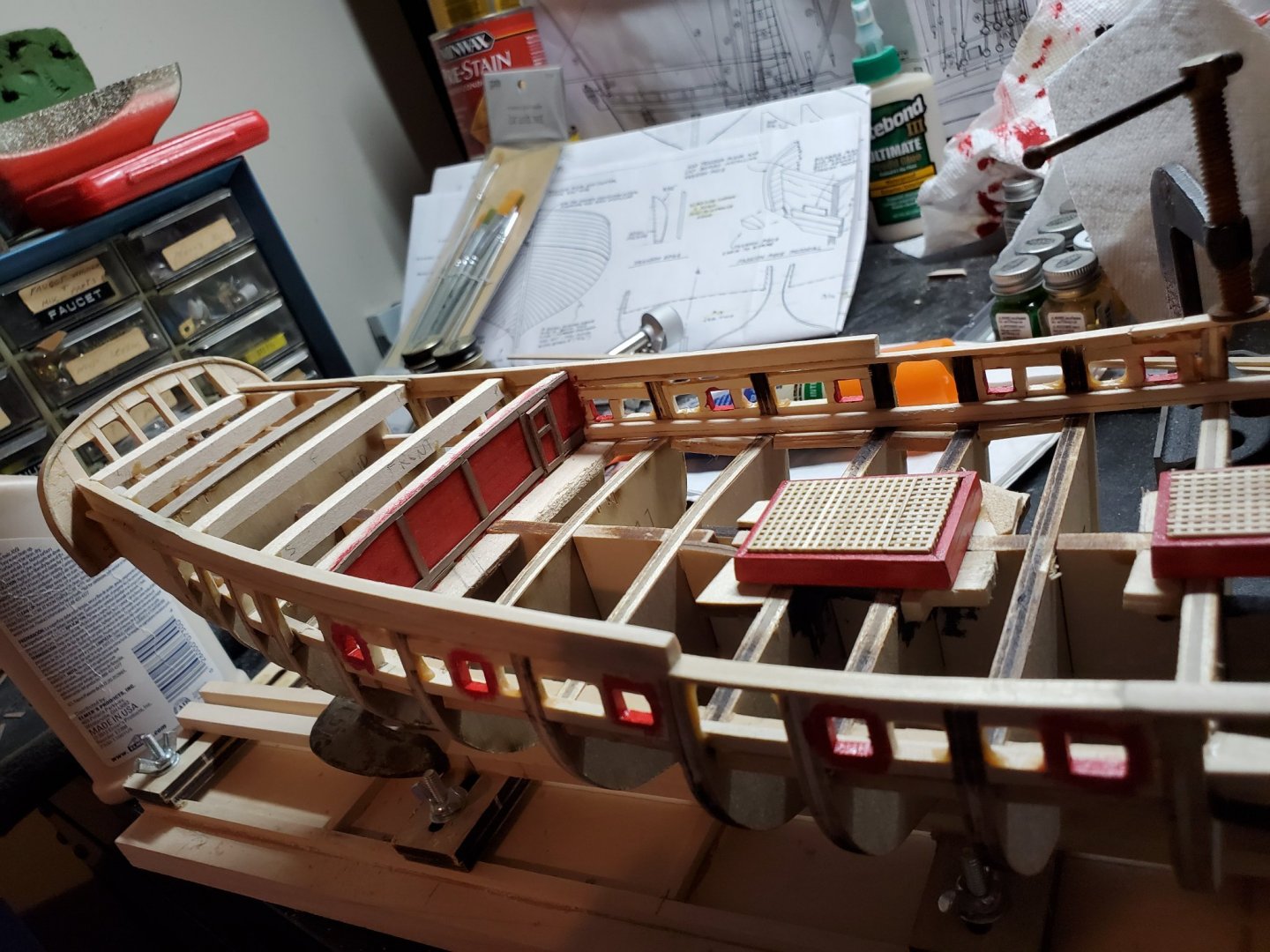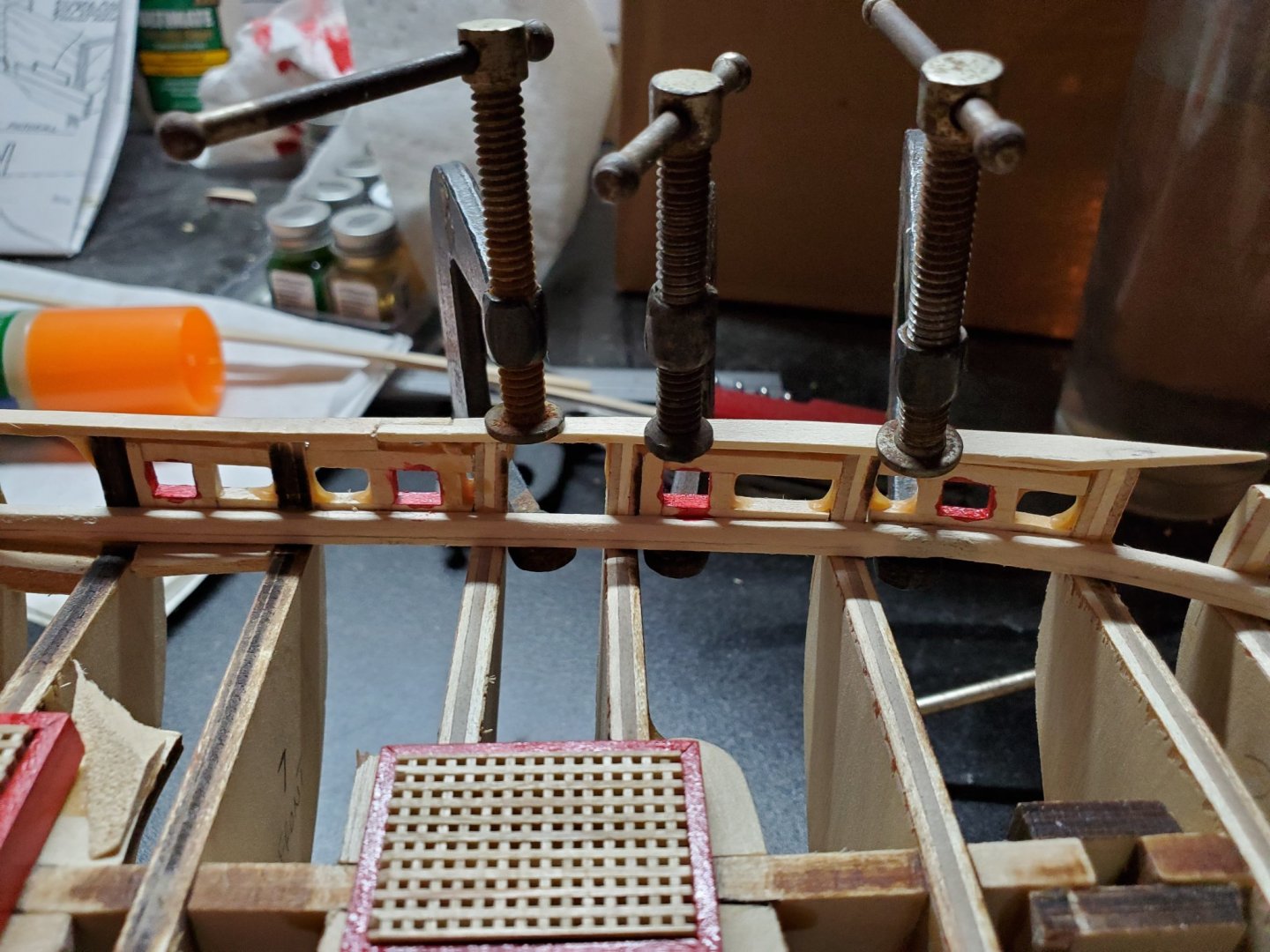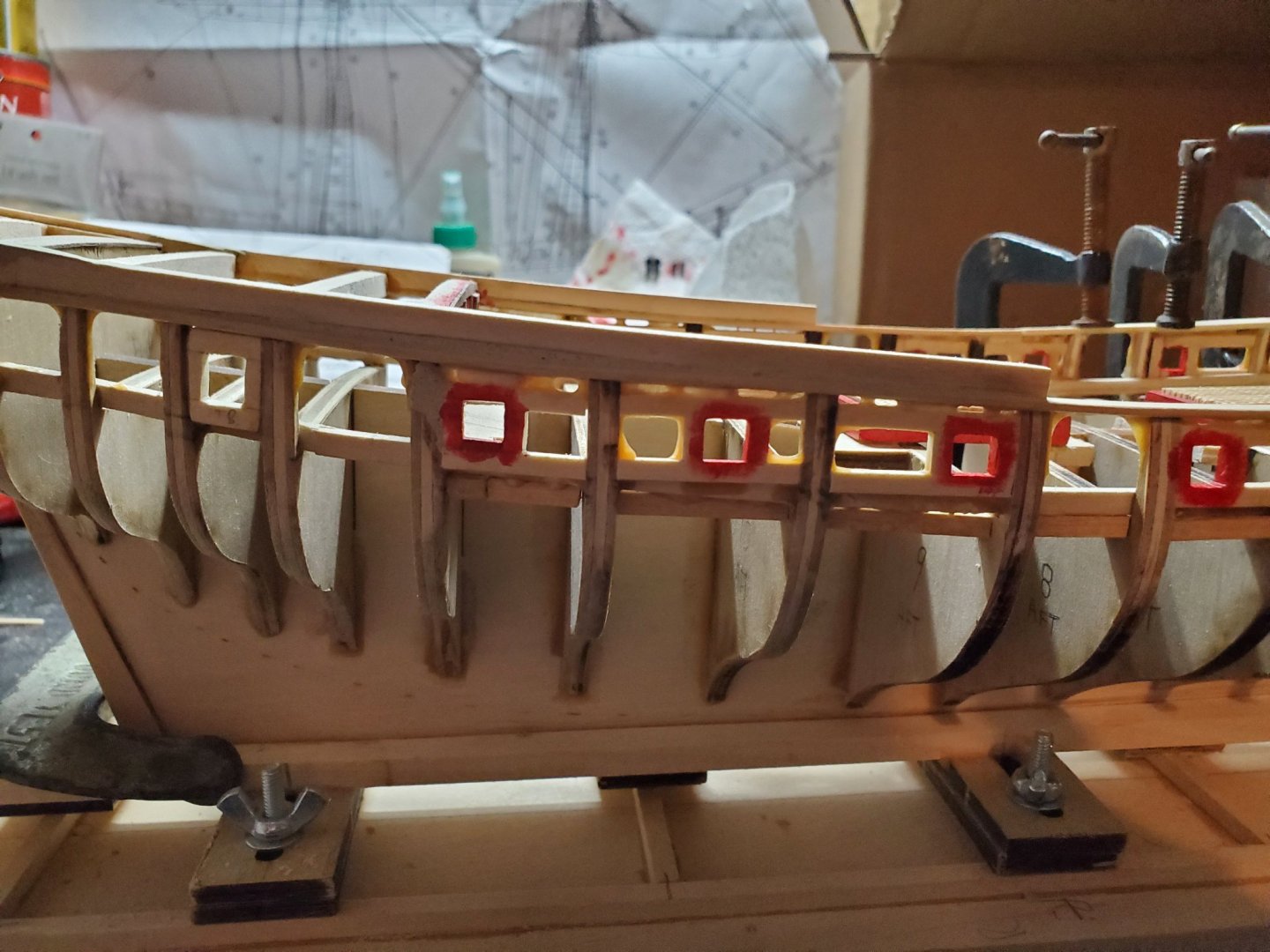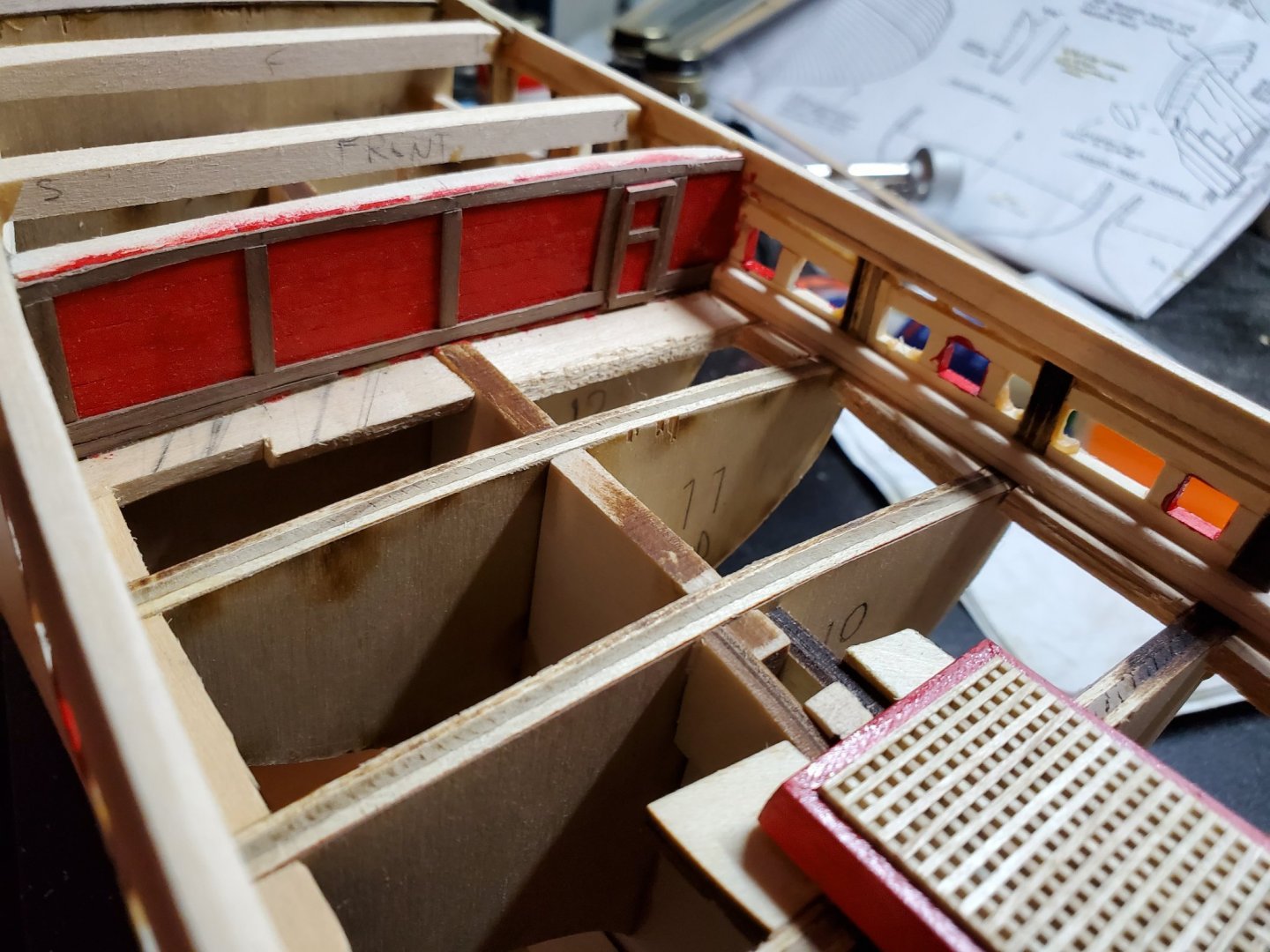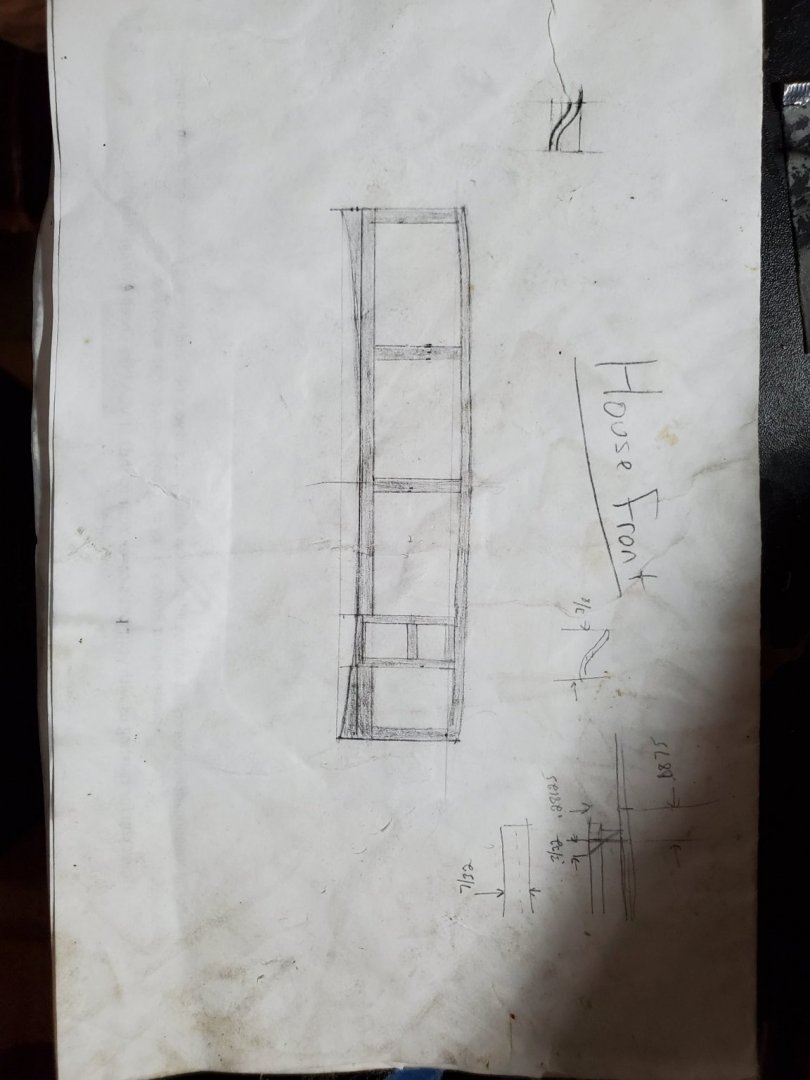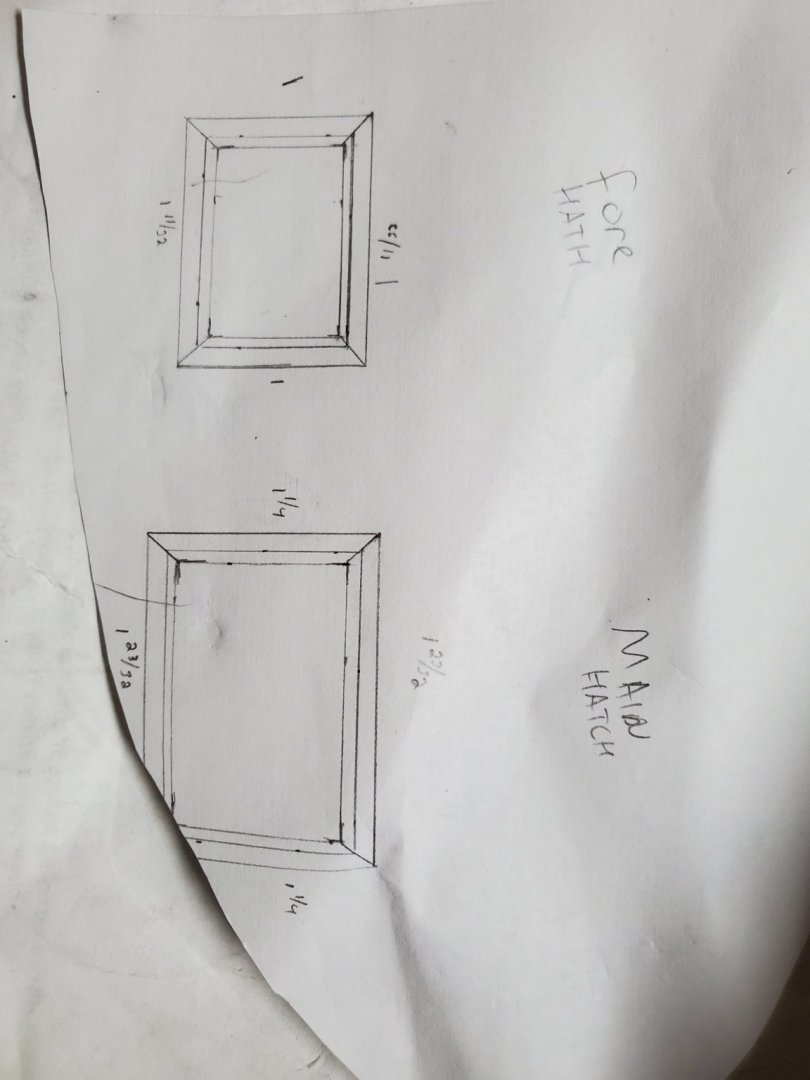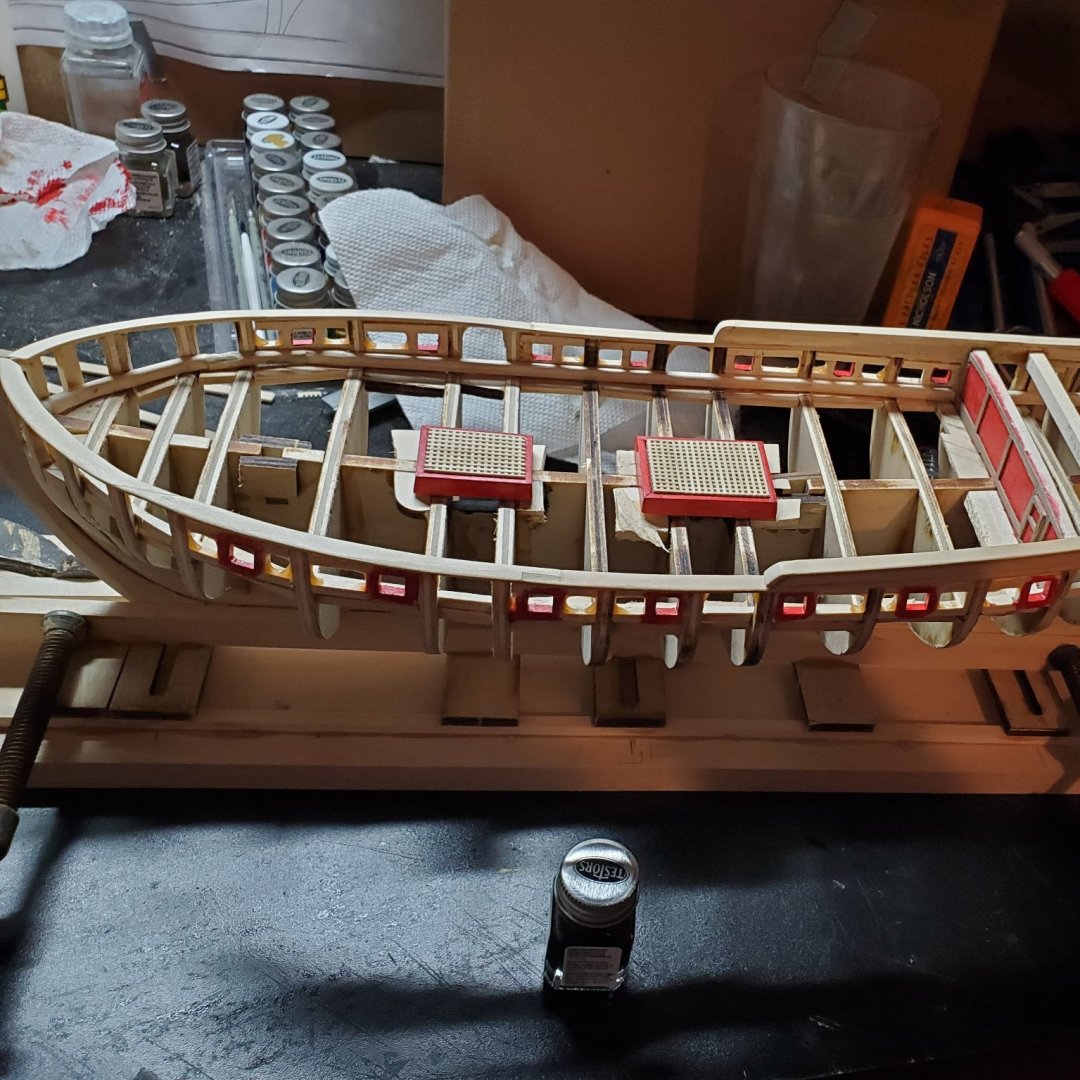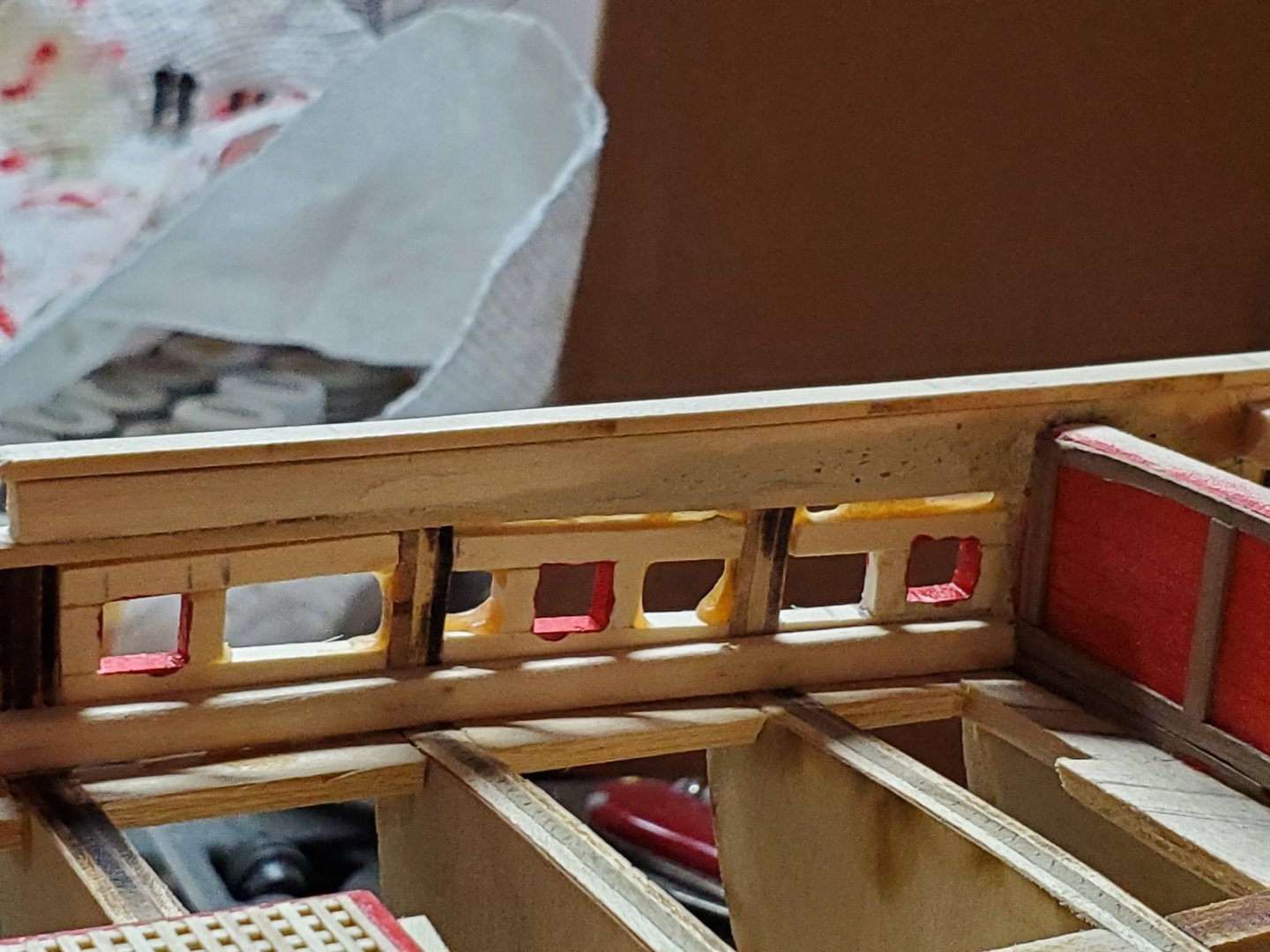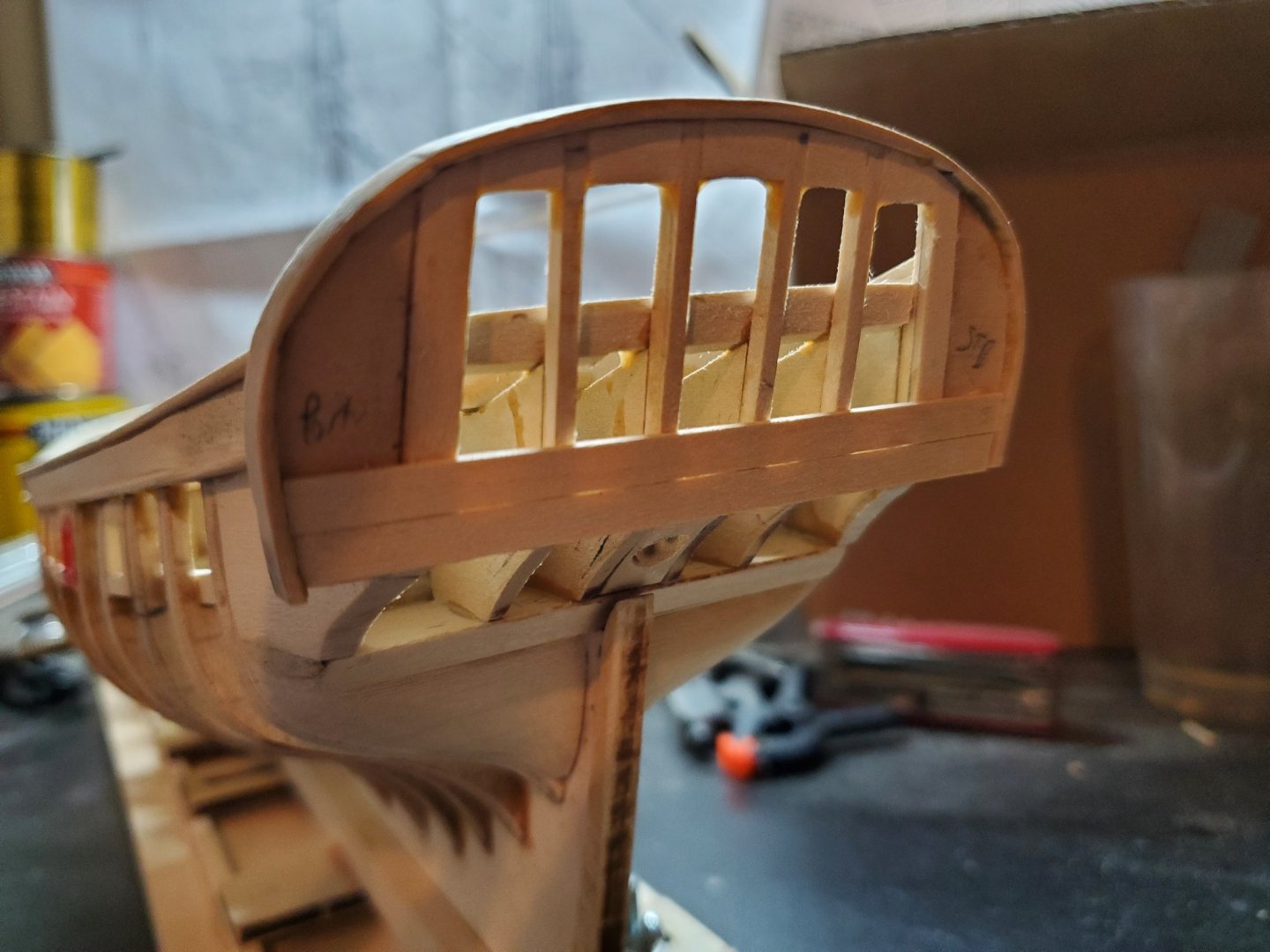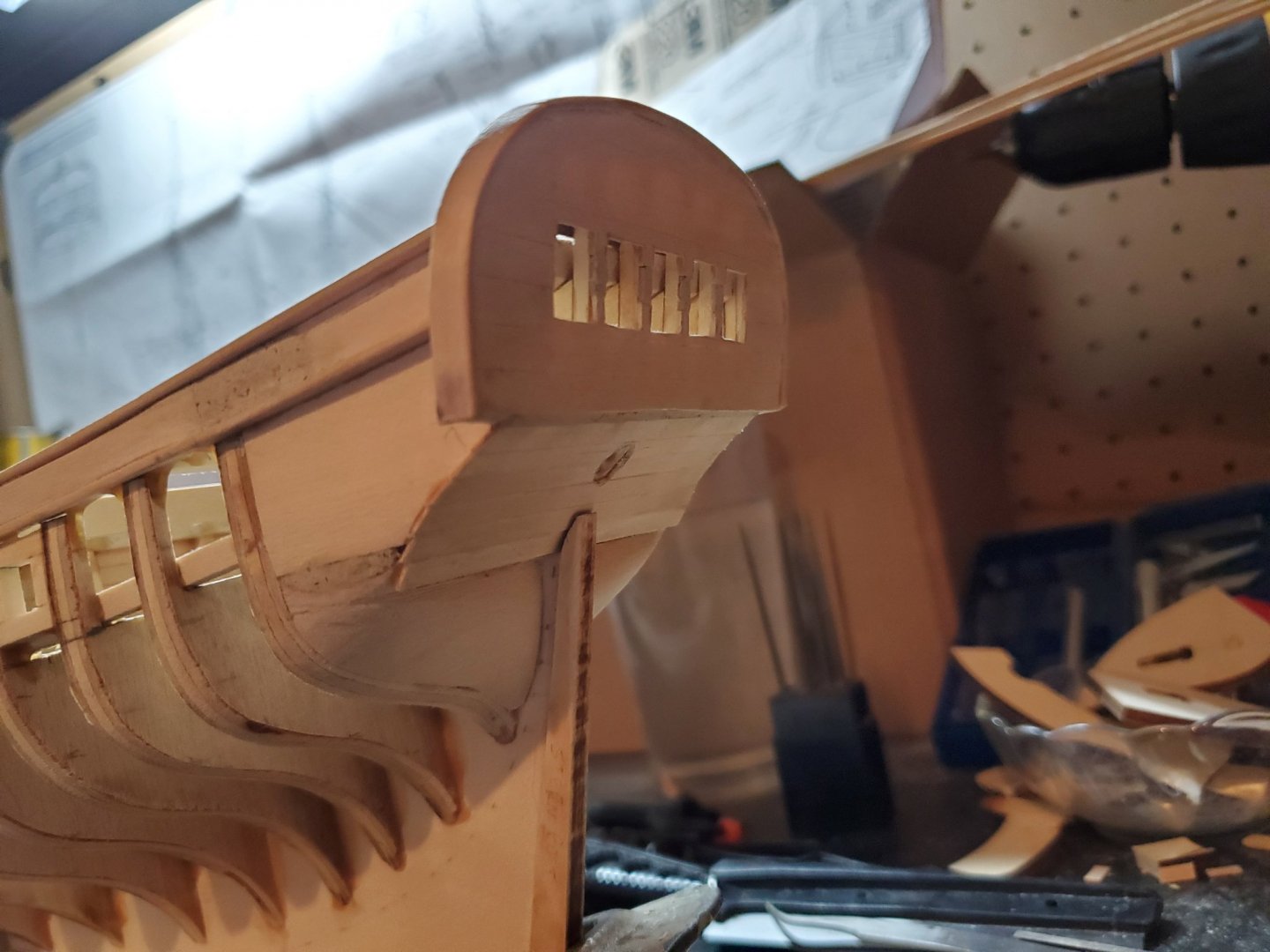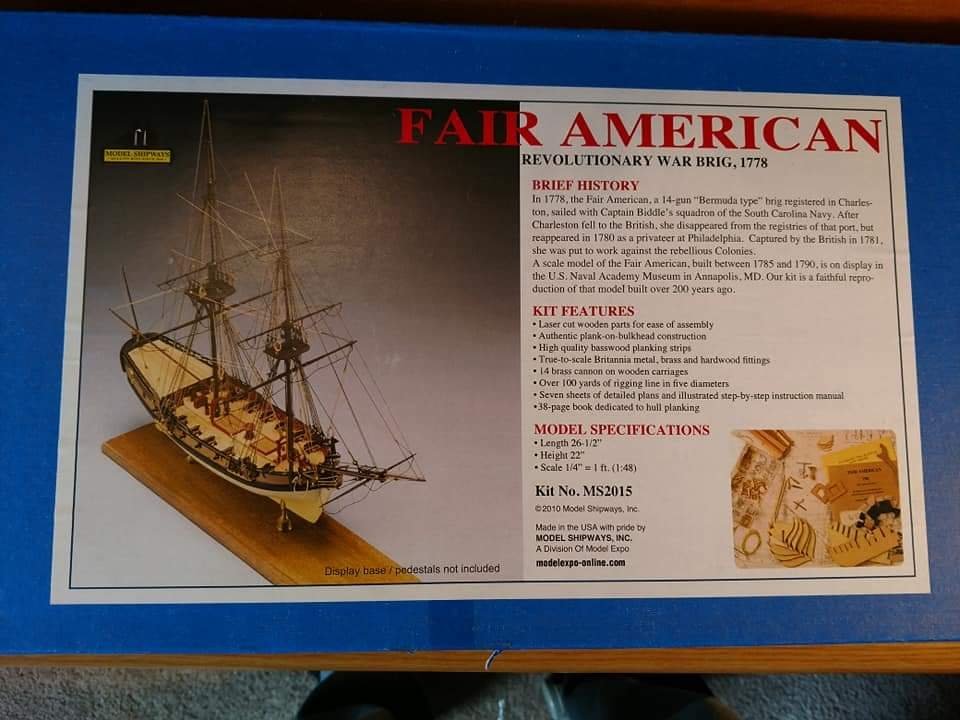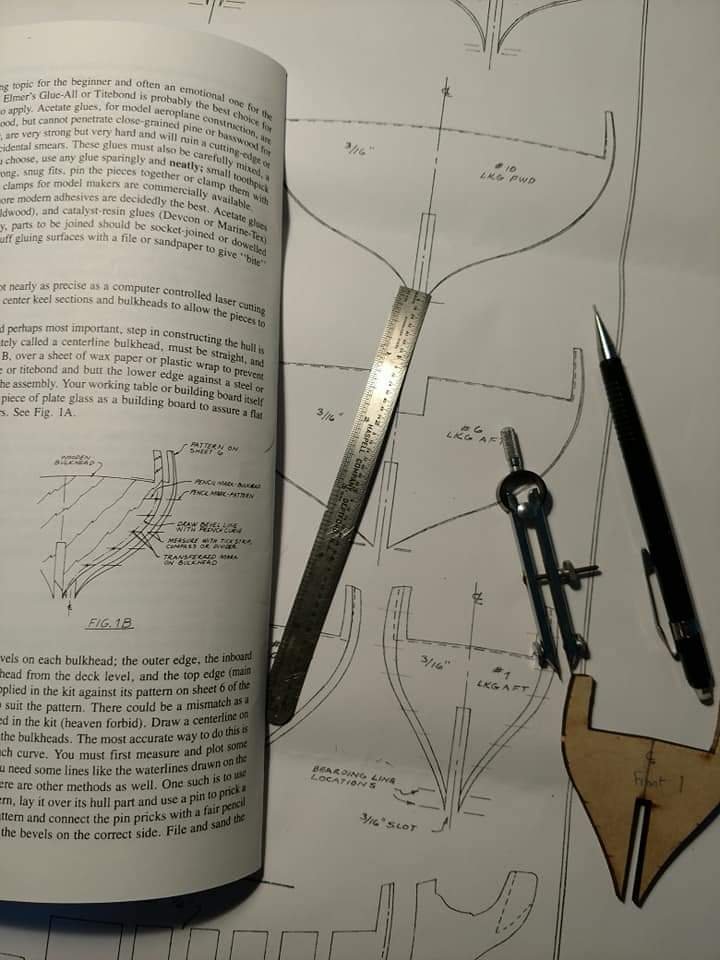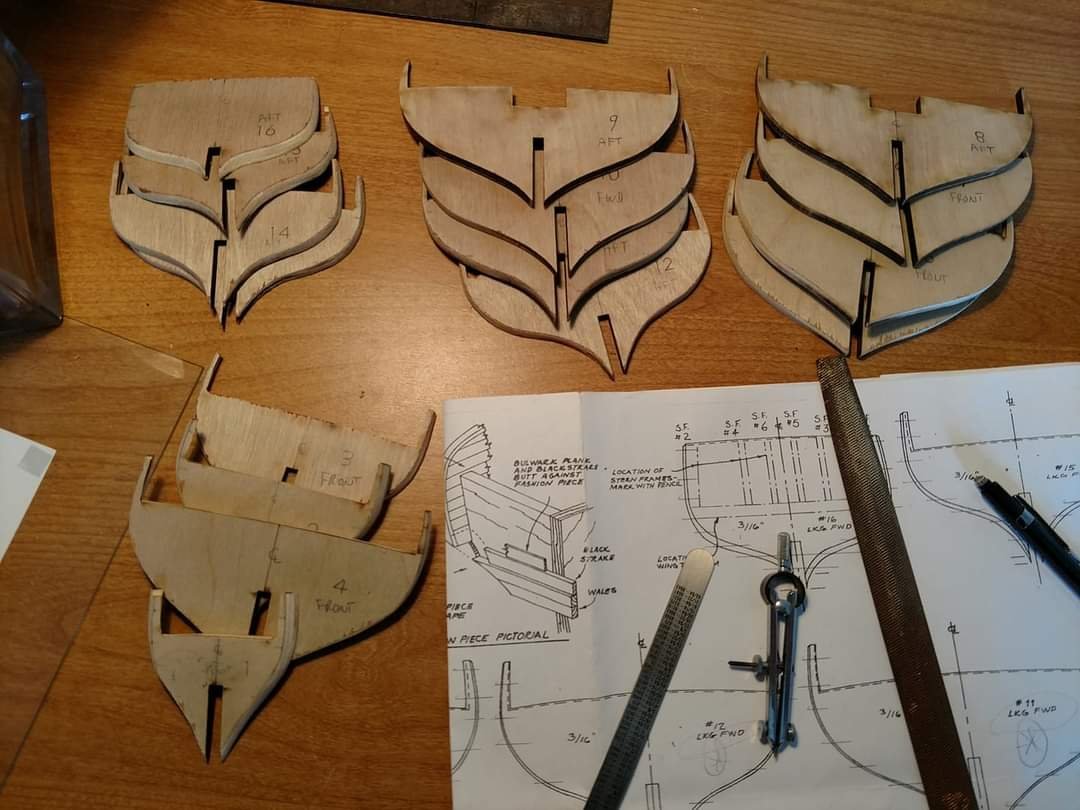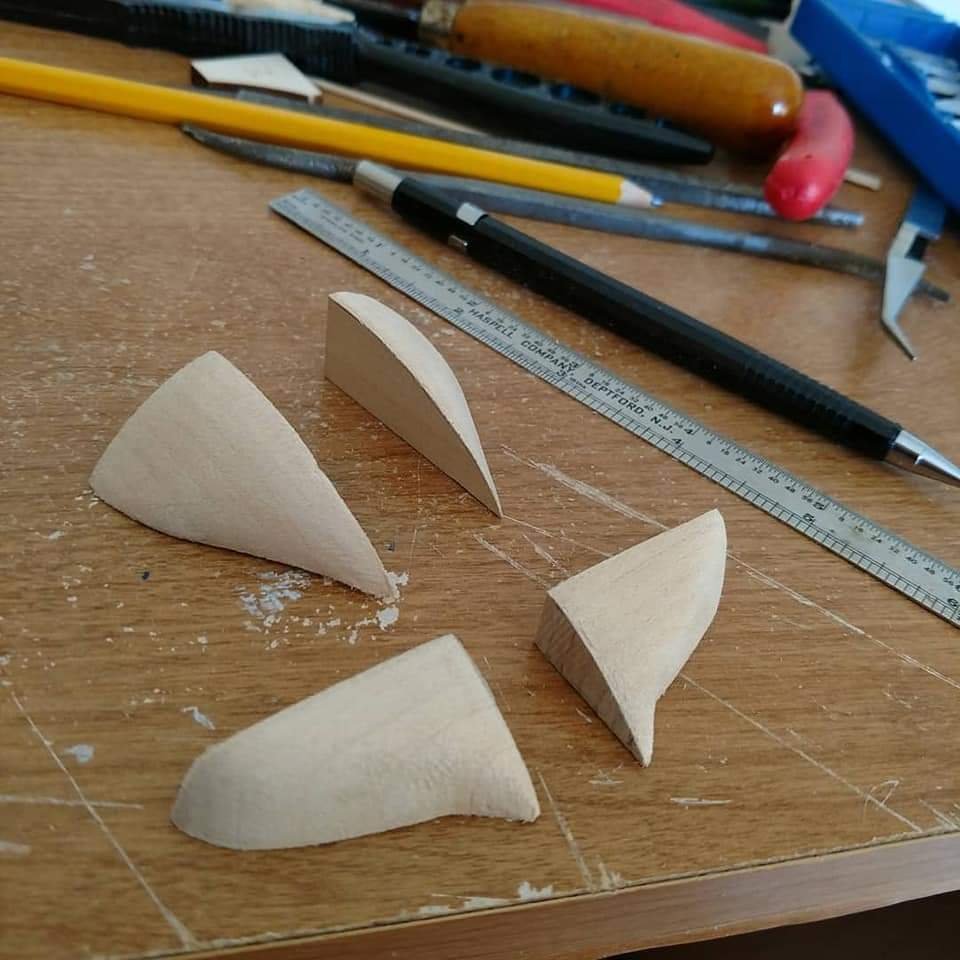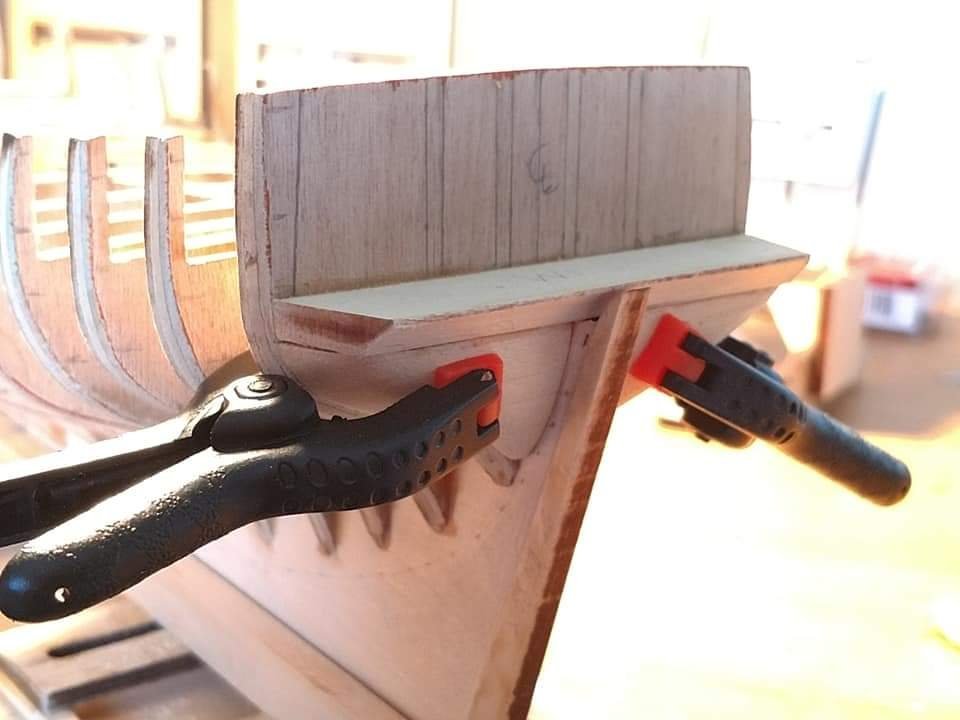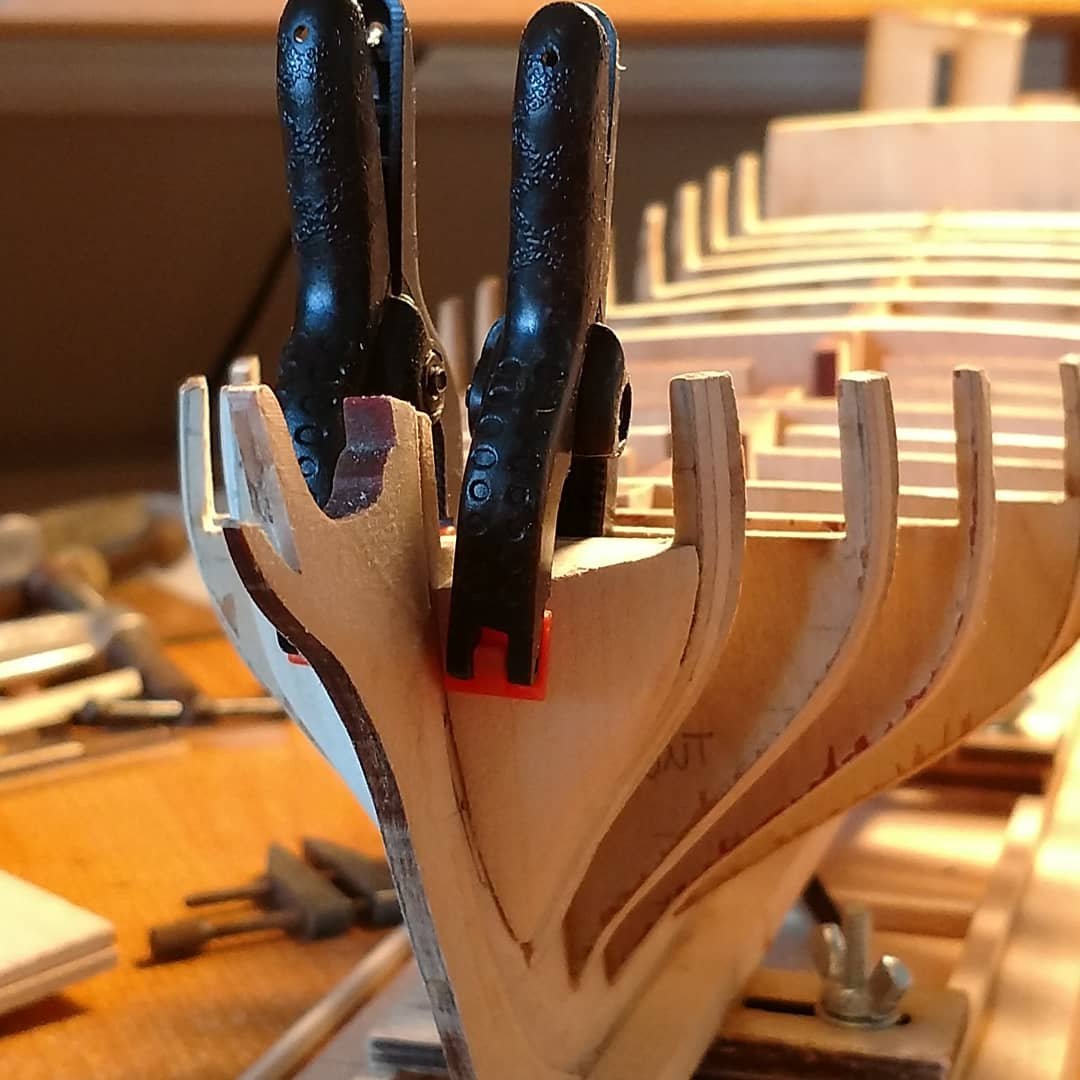-
Posts
110 -
Joined
-
Last visited
Content Type
Profiles
Forums
Gallery
Events
Everything posted by JLong
-
The start of hull planking for Fair American model ship: I had reviewed dozens of build logs, tips, tricks, videos and booklets on techniques of planking. Most of the modelers here have done a far better job than I did on planking. I mimicked a lot of them with my build. I bought an electric plank bender from ModelExpo, but ended up not using it at all. Instead, my process was measuring the gap left at each bulkhead divided by the number of planks left marked the strake width at each bulkhead drew a fit line along the marks cut with Xacto knife sanded edge smooth soaked in water for >1hr fit tightly against last strake on the model and clamped until dried glue to bulkheads and clamped repeat on opposite side I wanted to soak and clamp each plank, so that it perfectly 'fit' to the real model it was going onto. I should have done the planking BEFORE the main rail was installed, because trying to get clamps on there, was impossible - the rail was in the way! I was following the instructions, so I blame them 😉 I tried to add planking belts/battens to the model, as per the planking booklet. It said to divide the hull evenly, and lay the battens so they run naturally with the curve of the ship. When I did this, they bent all over the place, and I didn't want to force them to go where I wanted. Especially at the bow, they pinched too tightly, when allowed to run naturally. So I ended up doing 22 total planks, and measured that way. I went WAY overboard (get it?!?!) with finding plank widths. As in, super overkill. I made a strip of index card into a flexible ruler, and drew 1/32" marks up to 6" (no shown). That way I could measure the gap left along the curve of the bulkheads. I'd write that number for each one, for each side on an index card. I created this excel sheet to calculate the width left, by the number of planks left, at each bulkhead. I even made a tab for butt placement, so I can keep track of which one goes where. I went so far as to make the space between bulkhead #'s the same # of units wide for each cell, so that it looks appropriate. Planking width & Butts.xlsx After getting the width for each plank at each bulkhead, I used a magnifier and a machinist ruler (to 1/64"), to get as close to the width as possible. 1/2 spaces between 1/64" counts as 0.008in!! Next, I'd draw a best-fit curve between points - no sharp tapers, just smooth curves. I'd cut the entire complete length of plank to size, not short planks. It became easier to soak and shape the entire plank to the hull, rather than little pieces. Cutting with an Xacto knife went okay, but sometimes I ended up splitting the grain, or beveling the edge out. I attempted to sand it smooth as best I could, by running it back and forth over a flat file. I would then glue the entire length of plank to the ship, clamping tight in spots. Once dried, I would simulate the planking butts, by slicing that plank at the locations from my Excel sheet down about 2/3 thickness. I know, its cheating. I wasn't satisfied with the first actual butted planks, because they didn't mount on the bulkhead without sticking up a little. I figured if they had to be sanded flush to each other, I must have done it wrong. So I decided on one long plank, glued and sliced the butts after-the-fact. The Garboard strake went in pretty easily, no real curvature yet. The rabbet didn't offer anything here. I used the clamps to fit it near the keel, but it sticks out about 1/32". I should have made the rabbet deeper. I'll have to sand it down later...which will be a pain. I used a scrap piece of Styrofoam to hold the hull upside down. I needed to chunk out a bunch of pieces to accommodate the bow, but it works nicely!
-
Progress on the Fair American: Chasing wales - As described in the planking booklet, I drew the water line on the bulkhead frames, to indicate, what I thought, was the bottom of the lowest wale. With my hull stand holding the keel level, as described, I measured SEVERAL times to make sure I had the height right. After measuring where the 2 wales would go above the water line, and the black strake, I found it would be extremely close to the gun ports. This wasn't correct. I triple checked, and if the wales were any lower, they'd run back to the stern and end up in the middle of the counter somewhere - also not correct. To make the upper hull and gun ports not look squished, I made the decision to split the difference: Water line in the middle of the wales at Bulkhead 9. This looked much better. I soaked the wales for a good couple hours, then clamped them to the hull. It wasn't indicated how to plank the wales into the rabbet - obviously too shallow, so I sanded in a little 'bump' to notch into the rabbet. Worked pretty nicely. I did the same for the black strake above the 2 wales. And, with my wale correction, the black strake doesn't crowd the gun ports. Perhaps this is why I've seen other modelers raise the height of the bulwarks to give more room? Lower hull planking is next!!! - Jason -
-
More work on the Fair American model Ship: I shaped and glued the molding/false main rail under the quarterdeck, and used clamps to hold them in place. I wanted to start on the quarterdeck rail, so I pre-notched the stern and pre-drilled a hole for the timber heads. Thankfully, I didn't install anything, as the clamps wouldn't reach otherwise. I took the time to fabricate the timber heads, with the dowels and a slight taper. Leaving them stuck to the duct tape afterwards seemed like a good idea, so I don't loose these little guys down the road. Not shown, but I did finish the inboard planking. I think I mixed up some of the plank widths here, as the later outboard bulwark planking I didn't have enough 5/32'' width. I mixed in some 1/8" with it- more on that later. Apparently every 1/32" matters! Measure twice, cut once...measure twice, cut once. After the inboard planking, I used Floquil Bulwark Red for the paint. Its a bit glossy, but sounds like the right shade, so I went with it. Next was getting ready for some outboard planking! Dreaded and excited to start. As stated before, the filler blocks at the bow were undersized. I followed the planking booklet, where it said to use a scrap plank to follow the shape of the hull/bulkheads to look for any dips or high spots. Bulkheads 1 & 2 were two of those places. To correct, I glued on a piece of walnut plank, then some wood filler, and sanded best I could. Its ugly. It smoothed out the dip in the bulkhead, but its ugly.
-
More updates on the Fair American Model Ship: My workbench isn't as roomy as I'd like. Its basically a small desk in the garage corner, and lighting leaves something to be desired. At about the 6month mark, working on it a few hours a week of course, I managed to get some paint on the transom, main and fancy rails. This was important now before any planking could begin, so that once the main and quarter deck are installed, I won't have to go back and worry about paint getting everywhere, especially the rails and waterways. A few weeks later, I got all the quarter deck planked. I used the supplied 1/8" deck planks, as per the instructions, even though the plans show 1/4" wide planks. There wasn't a dramatic camber to the quarter deck, but still looks nice - I made sure to rub the sides of each plank with a brown colored pencil for caulking effect. I used a small drill bit to make little pockets to simulate treenails holes, then just spun a 0.5mm led pencil inside a few times to darken them. I added a thin coat of clear poly and voila! For the transom windows, I took the cast frames from the kit, filed and then painted gold. I saw another modeler come up with a neat trick to mimic glass: clear plastic from an envelope. Genius! I used the same technique here. CA glue worked fine for the most part, but did smear in a few spots, and it isn't perfectly taut everywhere, but I like the effect. After they were glued in place, I added the counter molding, then painted with some more gold. It really pops! I didn't do the lettering or the curtains yet, but I'll need to eventually, once the wales are installed. Slow and steady progress.... - Jason -
-
More progress on the Fair American: Most of these pictures were not originally for a build log in mind, but more for my own little story, so I pieced together what I had and described best I can remember. I also am big on building by-the-book. Since I have no experience with ship building to know of any inaccuracies with the model, I will be following the instructions and plans very closely. Things like door height, gun port size, etc. I will not be altering. Complete historical accuracy is difficult to hold to, since this is a model of a model. The main rail was a challenge for me. I first tried cutting it based off the plans, but the actual model bulkhead curvature and positions weren't the same. Instead I had to place/clamp a sheet of wood over the actual bulkheads on the model, and draw an outline underneath the sheet. From there, I measured the rail shape, with dimensions inboard/outboard that way. Even still, I wasn't happy with the result, once I clamped the rail and glued. Some bulkheads had more rail inboard than outboard, others vice-versa. Scarfing the pieces together was also tricky. I didn't know how big to make them, so I approximated. Once sanded smooth and painted, the junky edges were hidden. However, the planking will be uneven at the edges of the rail, because of the aforementioned problems with its shape. I am not planning on double planking, so when I got to the house front, I had the idea to use the walnut plank to create molding. I think it looks pretty nice, actually. I made a hand sketch and used its dimensions to fit to the model. In hindsight, I should have offset the house front up, so the deck planks wouldn't cover the bottom molding - another learning moment. The same thing was done with the hatches - sketched, measured and built per-sketch. The hatches are a focal point when I look at the model, so I spent a lot of time on these. As per the instructions and plans, I kept the gun ports 1/4" square. A lot of shaping and sanding so that they follow the shape of the rail and eventual deck, and still 1/4" square. A bit of paint, and we're moving right along More progress updates soon - Jason -
-
Continuing with the progress on the Fair American. I saw other builders add blocks between bulkheads, and it makes sense, however I didn't have spare wood to use and I felt the gun port framing and waterways would strengthen them sufficiently, so I moved forward without. I soaked the waterways for a few hours in water, then clamped them to the bulwarks to shape. I decided to omit the covering boards, as they proved too difficult to shape properly. I really had to stare at the plans for the transom, to understand the exact shape. The transition from the counter into the filler block and lower hull was tricky, but I figured it out. The cap rail was cut and clamped to the transom after soaking, it kinked, I left it on the table, re-soaked and clamped again, broke and re-glued together, then glued to the framing. I should have gone slower with the bending, but I got impatient - it eventually turned out okay, but I learned! The thick fancy rail was really difficult to shape. Bending to the curve of the hull wasn't bad, but the top flexed outward after gluing. Looking from the stern, you could see it bow outward, so I attempted to sand it back to follow the tumble of the bulwarks - not fun. I also had to add a bunch of wood filler to smooth different sections out. One other issue was that I had to 'chock' some filler wood above stern frames #1 & #2, in order for the main and fancy rail to continue straight back. The frame wasn't ''tall'' enough for some reason; I think I fixed it OK. I decided to use 5 windows, and not 7. The outer windows would be for decoration anyway, if present - they don't serve any real purpose, so I omitted them. The transom planking was next. I made sure the transom framing was sanded parallel, checking with a thick piece of wood along the counter so that all planks would be flush without dips. Its starting to look like something! More progress soon - Jason -
-
This will be my first wooden ship model; I completed a Revell HMS Victory plastic model ship a few years ago, and I really liked it. It sparked my interest in wooden model ships, and I wanted to build one of my own. My father bought this kit for Christmas in 2019, and I really like the overall shape of the hull. Even though this is my first wooden model and the kit doesn't have them, I'd like to add sails. It will be a challenge, especially the rigging, but I believe I can do it. I started this model at the end of December 2019, and am currently working on the bow section, so maybe ~1/2 way done. I will share photos and construction details up to this point, and then continue to post progress as I go. I work full time during the day, so I only have a few hours a week to dedicate to the build, so my progress after a year and a half is SLOW. I have seen a lot of other builds/ships with high quality planking. I hope that mine will be good enough to leave unpainted, since I really like the look of the hull planking As with other builders of the MSW's kit, the keel is short ~1/4". I used a piece of extra wood to shape and glue the missing portion. Not awesome, but acceptable. I also purchased a Bulkhead Mounting Kit from a local hobby shop. After reviewing the plans, I cut the bulkhead frames loose, sanded and transferred the bevels with a compass. The rabbet was a pain....chiseling didn't do well, so I ended up sanding. A lot of sanding. In hindsight later on, I should have sanded deeper. I shaped the bulkheads and glued to the frame using the Mounting Kit. I squared them to the model with C-clamps on each end, and slowly tightened until I measured the distance between bulkheads was the same on both sides. The Filler blocks took a while to shape right, and even after they were glued, they needed more sanding to get blended with the bulkheads. Next time I might leave the bulkhead bevels ''thick'' and sand together with the blocks for a better transition. More photos and progress tomorrow -Jason-
About us
Modelshipworld - Advancing Ship Modeling through Research
SSL Secured
Your security is important for us so this Website is SSL-Secured
NRG Mailing Address
Nautical Research Guild
237 South Lincoln Street
Westmont IL, 60559-1917
Model Ship World ® and the MSW logo are Registered Trademarks, and belong to the Nautical Research Guild (United States Patent and Trademark Office: No. 6,929,264 & No. 6,929,274, registered Dec. 20, 2022)
Helpful Links
About the NRG
If you enjoy building ship models that are historically accurate as well as beautiful, then The Nautical Research Guild (NRG) is just right for you.
The Guild is a non-profit educational organization whose mission is to “Advance Ship Modeling Through Research”. We provide support to our members in their efforts to raise the quality of their model ships.
The Nautical Research Guild has published our world-renowned quarterly magazine, The Nautical Research Journal, since 1955. The pages of the Journal are full of articles by accomplished ship modelers who show you how they create those exquisite details on their models, and by maritime historians who show you the correct details to build. The Journal is available in both print and digital editions. Go to the NRG web site (www.thenrg.org) to download a complimentary digital copy of the Journal. The NRG also publishes plan sets, books and compilations of back issues of the Journal and the former Ships in Scale and Model Ship Builder magazines.


